The Impact of Digital Technology on Business Activity: A Case Study of TUI Group
VerifiedAdded on 2024/06/27
|33
|6375
|435
AI Summary
This research paper investigates the impact of digital technologies on the business activities of TUI Group, a leading travel and tourism company. The study explores the positive and negative effects of digitalization on various aspects of the business, including market research, employee productivity, human resource management, and overall business performance. The research utilizes a mixed-methods approach, combining quantitative data analysis from surveys with qualitative insights from interviews with managers. The findings reveal that digital technologies have a significant positive impact on TUI Group's business activities, enhancing efficiency, customer engagement, and strategic decision-making. However, the study also highlights challenges associated with digital transformation, such as high implementation costs and the need for continuous adaptation to evolving technologies.
Contribute Materials
Your contribution can guide someone’s learning journey. Share your
documents today.
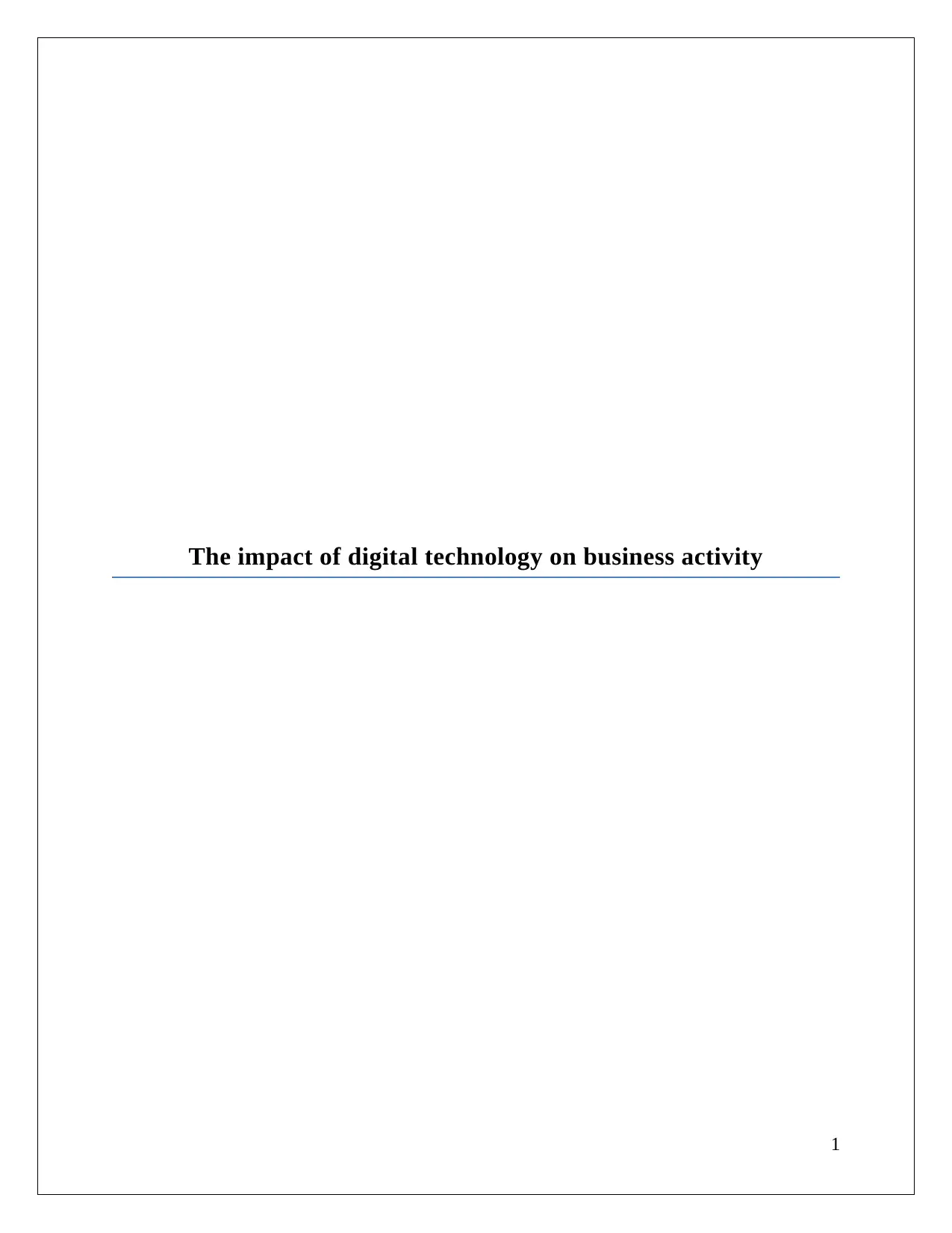
The impact of digital technology on business activity
1
1
Secure Best Marks with AI Grader
Need help grading? Try our AI Grader for instant feedback on your assignments.
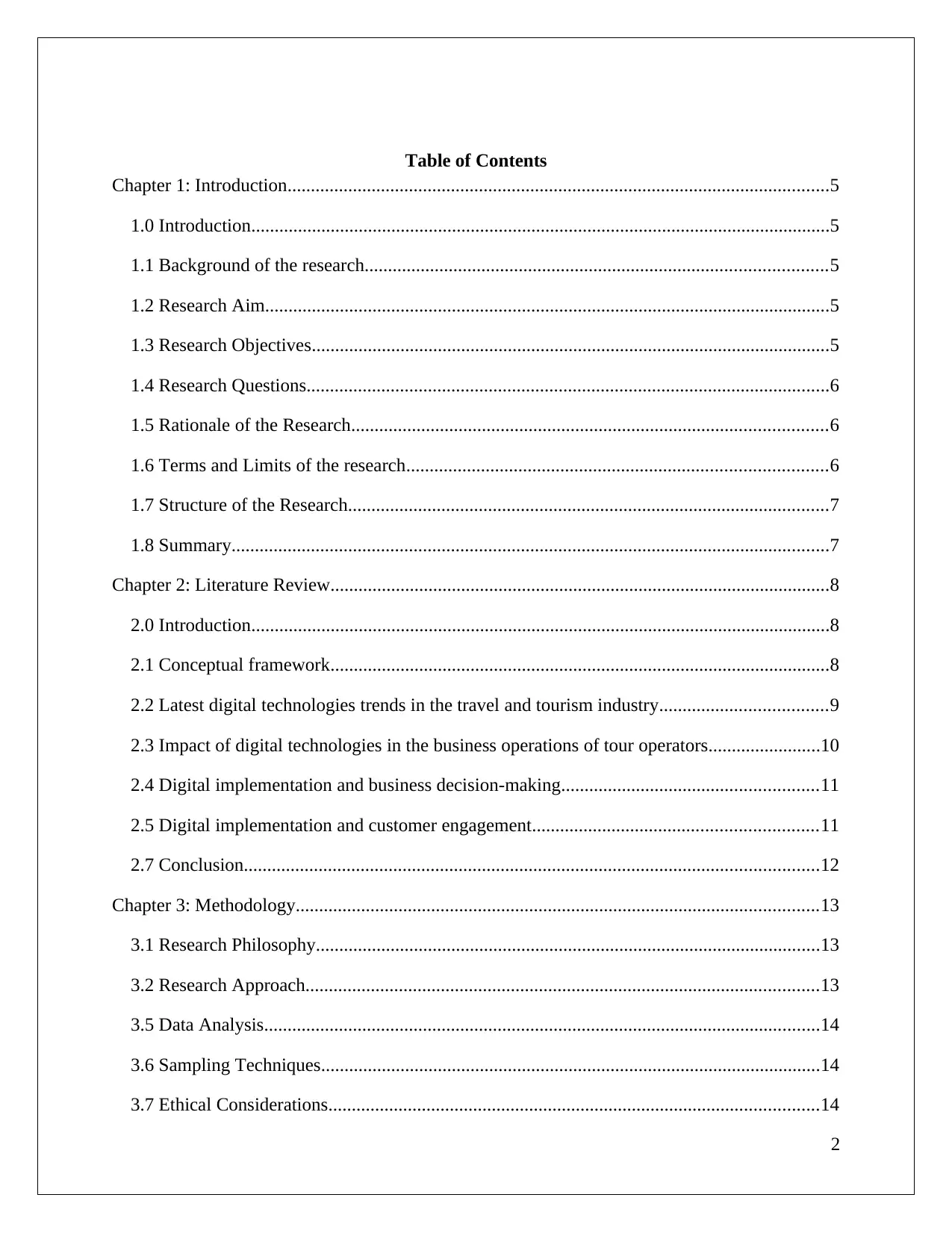
Table of Contents
Chapter 1: Introduction....................................................................................................................5
1.0 Introduction............................................................................................................................5
1.1 Background of the research...................................................................................................5
1.2 Research Aim.........................................................................................................................5
1.3 Research Objectives...............................................................................................................5
1.4 Research Questions................................................................................................................6
1.5 Rationale of the Research......................................................................................................6
1.6 Terms and Limits of the research..........................................................................................6
1.7 Structure of the Research.......................................................................................................7
1.8 Summary................................................................................................................................7
Chapter 2: Literature Review...........................................................................................................8
2.0 Introduction............................................................................................................................8
2.1 Conceptual framework...........................................................................................................8
2.2 Latest digital technologies trends in the travel and tourism industry....................................9
2.3 Impact of digital technologies in the business operations of tour operators........................10
2.4 Digital implementation and business decision-making.......................................................11
2.5 Digital implementation and customer engagement.............................................................11
2.7 Conclusion...........................................................................................................................12
Chapter 3: Methodology................................................................................................................13
3.1 Research Philosophy............................................................................................................13
3.2 Research Approach..............................................................................................................13
3.5 Data Analysis.......................................................................................................................14
3.6 Sampling Techniques...........................................................................................................14
3.7 Ethical Considerations.........................................................................................................14
2
Chapter 1: Introduction....................................................................................................................5
1.0 Introduction............................................................................................................................5
1.1 Background of the research...................................................................................................5
1.2 Research Aim.........................................................................................................................5
1.3 Research Objectives...............................................................................................................5
1.4 Research Questions................................................................................................................6
1.5 Rationale of the Research......................................................................................................6
1.6 Terms and Limits of the research..........................................................................................6
1.7 Structure of the Research.......................................................................................................7
1.8 Summary................................................................................................................................7
Chapter 2: Literature Review...........................................................................................................8
2.0 Introduction............................................................................................................................8
2.1 Conceptual framework...........................................................................................................8
2.2 Latest digital technologies trends in the travel and tourism industry....................................9
2.3 Impact of digital technologies in the business operations of tour operators........................10
2.4 Digital implementation and business decision-making.......................................................11
2.5 Digital implementation and customer engagement.............................................................11
2.7 Conclusion...........................................................................................................................12
Chapter 3: Methodology................................................................................................................13
3.1 Research Philosophy............................................................................................................13
3.2 Research Approach..............................................................................................................13
3.5 Data Analysis.......................................................................................................................14
3.6 Sampling Techniques...........................................................................................................14
3.7 Ethical Considerations.........................................................................................................14
2
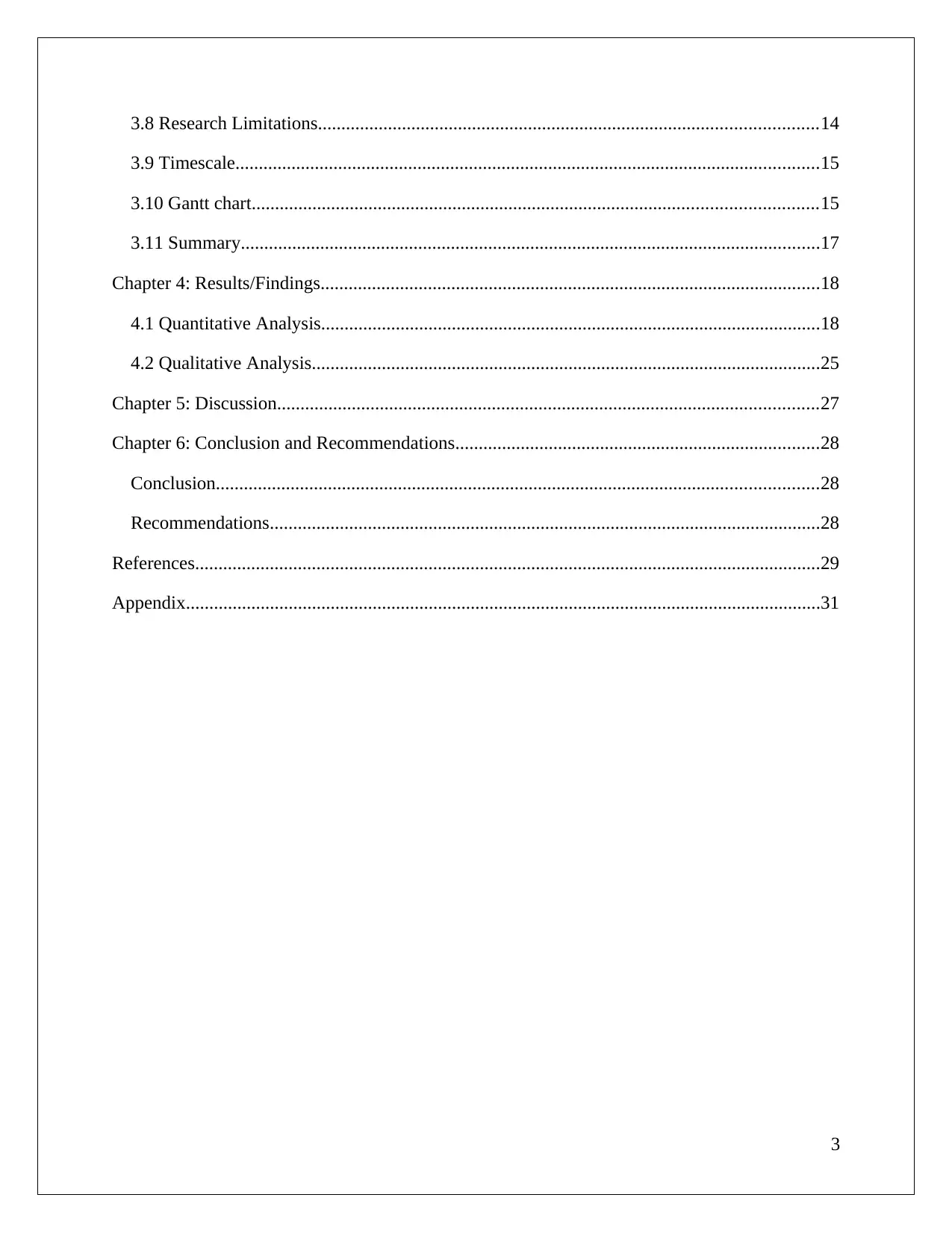
3.8 Research Limitations...........................................................................................................14
3.9 Timescale.............................................................................................................................15
3.10 Gantt chart.........................................................................................................................15
3.11 Summary............................................................................................................................17
Chapter 4: Results/Findings...........................................................................................................18
4.1 Quantitative Analysis...........................................................................................................18
4.2 Qualitative Analysis.............................................................................................................25
Chapter 5: Discussion....................................................................................................................27
Chapter 6: Conclusion and Recommendations..............................................................................28
Conclusion.................................................................................................................................28
Recommendations......................................................................................................................28
References......................................................................................................................................29
Appendix........................................................................................................................................31
3
3.9 Timescale.............................................................................................................................15
3.10 Gantt chart.........................................................................................................................15
3.11 Summary............................................................................................................................17
Chapter 4: Results/Findings...........................................................................................................18
4.1 Quantitative Analysis...........................................................................................................18
4.2 Qualitative Analysis.............................................................................................................25
Chapter 5: Discussion....................................................................................................................27
Chapter 6: Conclusion and Recommendations..............................................................................28
Conclusion.................................................................................................................................28
Recommendations......................................................................................................................28
References......................................................................................................................................29
Appendix........................................................................................................................................31
3
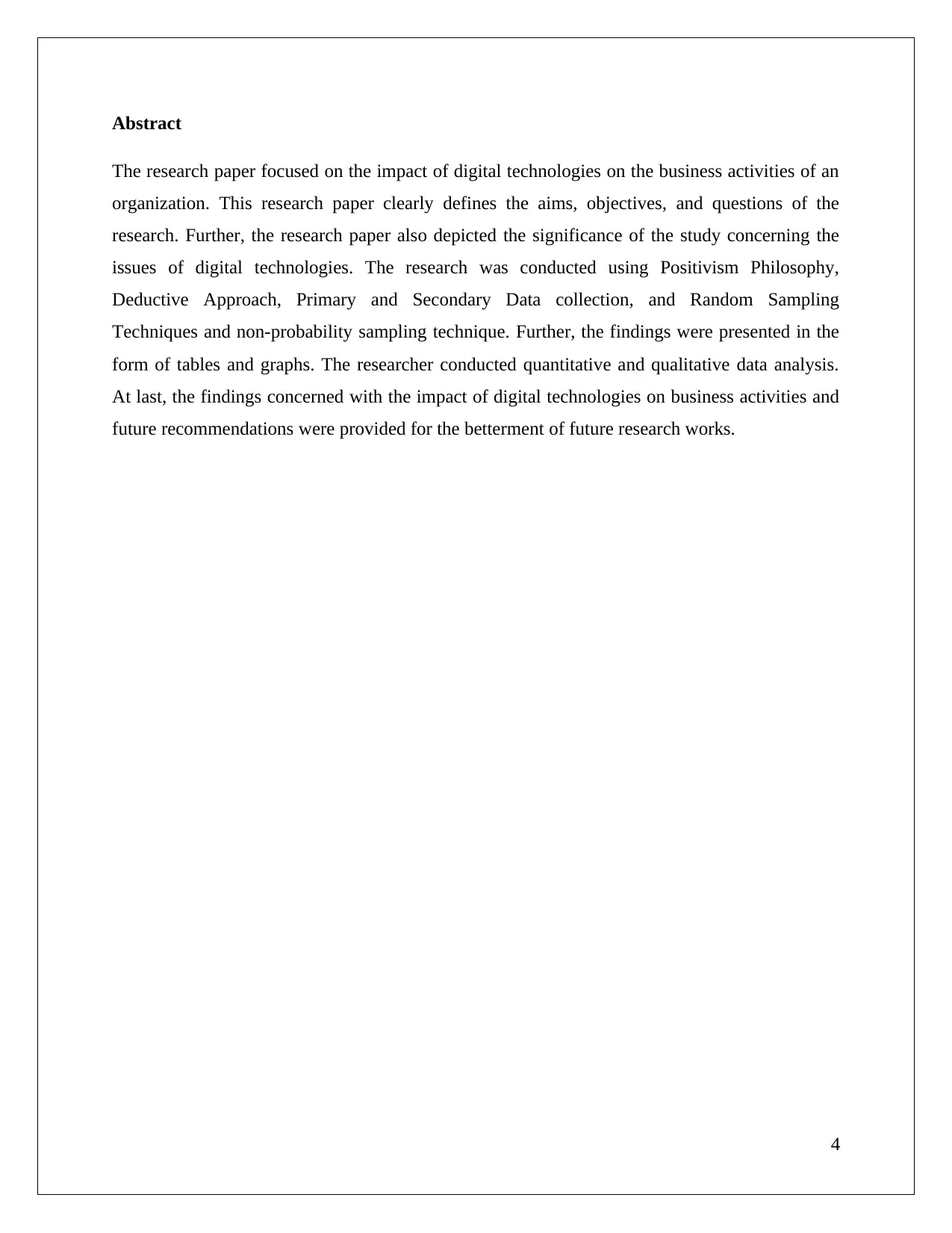
Abstract
The research paper focused on the impact of digital technologies on the business activities of an
organization. This research paper clearly defines the aims, objectives, and questions of the
research. Further, the research paper also depicted the significance of the study concerning the
issues of digital technologies. The research was conducted using Positivism Philosophy,
Deductive Approach, Primary and Secondary Data collection, and Random Sampling
Techniques and non-probability sampling technique. Further, the findings were presented in the
form of tables and graphs. The researcher conducted quantitative and qualitative data analysis.
At last, the findings concerned with the impact of digital technologies on business activities and
future recommendations were provided for the betterment of future research works.
4
The research paper focused on the impact of digital technologies on the business activities of an
organization. This research paper clearly defines the aims, objectives, and questions of the
research. Further, the research paper also depicted the significance of the study concerning the
issues of digital technologies. The research was conducted using Positivism Philosophy,
Deductive Approach, Primary and Secondary Data collection, and Random Sampling
Techniques and non-probability sampling technique. Further, the findings were presented in the
form of tables and graphs. The researcher conducted quantitative and qualitative data analysis.
At last, the findings concerned with the impact of digital technologies on business activities and
future recommendations were provided for the betterment of future research works.
4
Paraphrase This Document
Need a fresh take? Get an instant paraphrase of this document with our AI Paraphraser
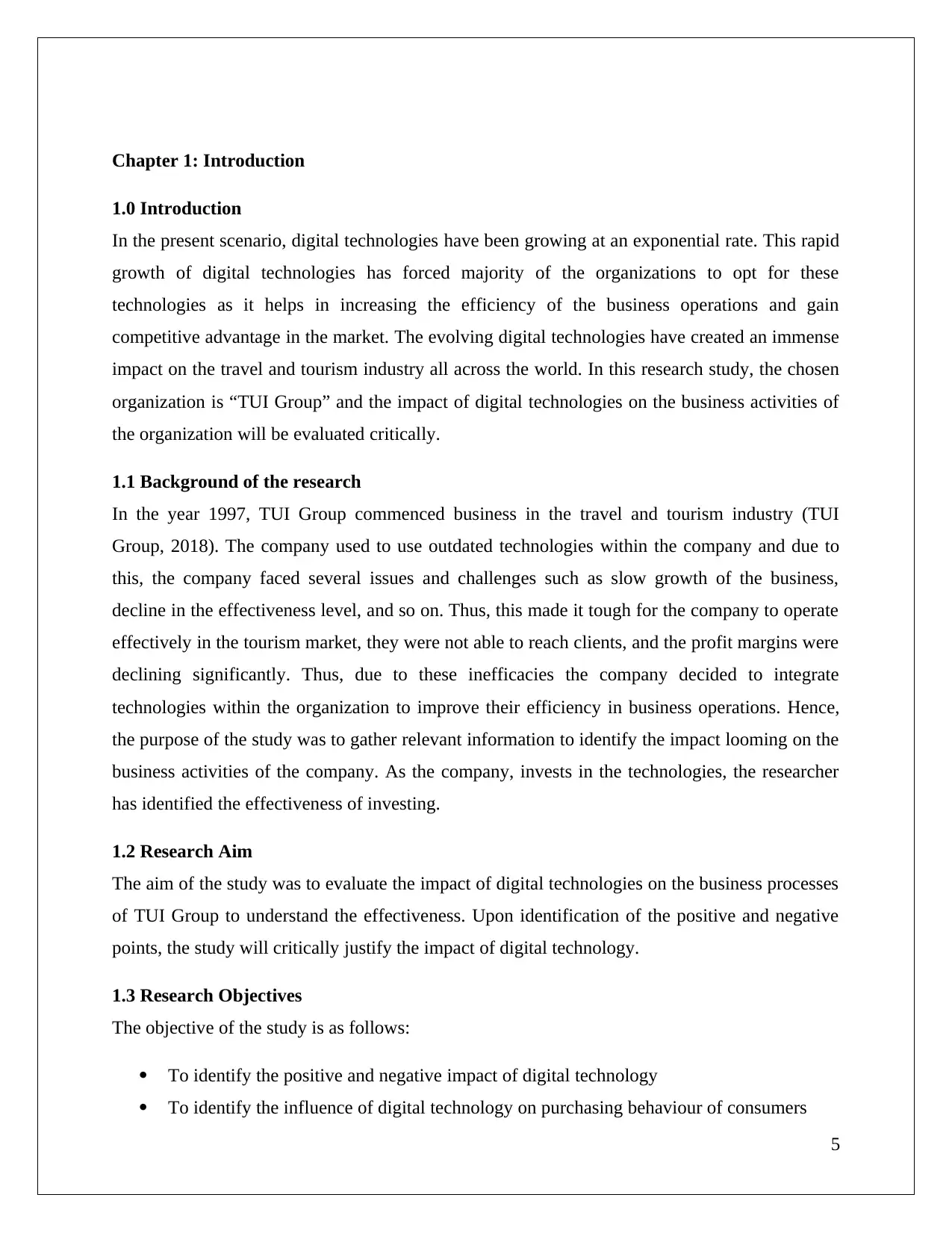
Chapter 1: Introduction
1.0 Introduction
In the present scenario, digital technologies have been growing at an exponential rate. This rapid
growth of digital technologies has forced majority of the organizations to opt for these
technologies as it helps in increasing the efficiency of the business operations and gain
competitive advantage in the market. The evolving digital technologies have created an immense
impact on the travel and tourism industry all across the world. In this research study, the chosen
organization is “TUI Group” and the impact of digital technologies on the business activities of
the organization will be evaluated critically.
1.1 Background of the research
In the year 1997, TUI Group commenced business in the travel and tourism industry (TUI
Group, 2018). The company used to use outdated technologies within the company and due to
this, the company faced several issues and challenges such as slow growth of the business,
decline in the effectiveness level, and so on. Thus, this made it tough for the company to operate
effectively in the tourism market, they were not able to reach clients, and the profit margins were
declining significantly. Thus, due to these inefficacies the company decided to integrate
technologies within the organization to improve their efficiency in business operations. Hence,
the purpose of the study was to gather relevant information to identify the impact looming on the
business activities of the company. As the company, invests in the technologies, the researcher
has identified the effectiveness of investing.
1.2 Research Aim
The aim of the study was to evaluate the impact of digital technologies on the business processes
of TUI Group to understand the effectiveness. Upon identification of the positive and negative
points, the study will critically justify the impact of digital technology.
1.3 Research Objectives
The objective of the study is as follows:
To identify the positive and negative impact of digital technology
To identify the influence of digital technology on purchasing behaviour of consumers
5
1.0 Introduction
In the present scenario, digital technologies have been growing at an exponential rate. This rapid
growth of digital technologies has forced majority of the organizations to opt for these
technologies as it helps in increasing the efficiency of the business operations and gain
competitive advantage in the market. The evolving digital technologies have created an immense
impact on the travel and tourism industry all across the world. In this research study, the chosen
organization is “TUI Group” and the impact of digital technologies on the business activities of
the organization will be evaluated critically.
1.1 Background of the research
In the year 1997, TUI Group commenced business in the travel and tourism industry (TUI
Group, 2018). The company used to use outdated technologies within the company and due to
this, the company faced several issues and challenges such as slow growth of the business,
decline in the effectiveness level, and so on. Thus, this made it tough for the company to operate
effectively in the tourism market, they were not able to reach clients, and the profit margins were
declining significantly. Thus, due to these inefficacies the company decided to integrate
technologies within the organization to improve their efficiency in business operations. Hence,
the purpose of the study was to gather relevant information to identify the impact looming on the
business activities of the company. As the company, invests in the technologies, the researcher
has identified the effectiveness of investing.
1.2 Research Aim
The aim of the study was to evaluate the impact of digital technologies on the business processes
of TUI Group to understand the effectiveness. Upon identification of the positive and negative
points, the study will critically justify the impact of digital technology.
1.3 Research Objectives
The objective of the study is as follows:
To identify the positive and negative impact of digital technology
To identify the influence of digital technology on purchasing behaviour of consumers
5
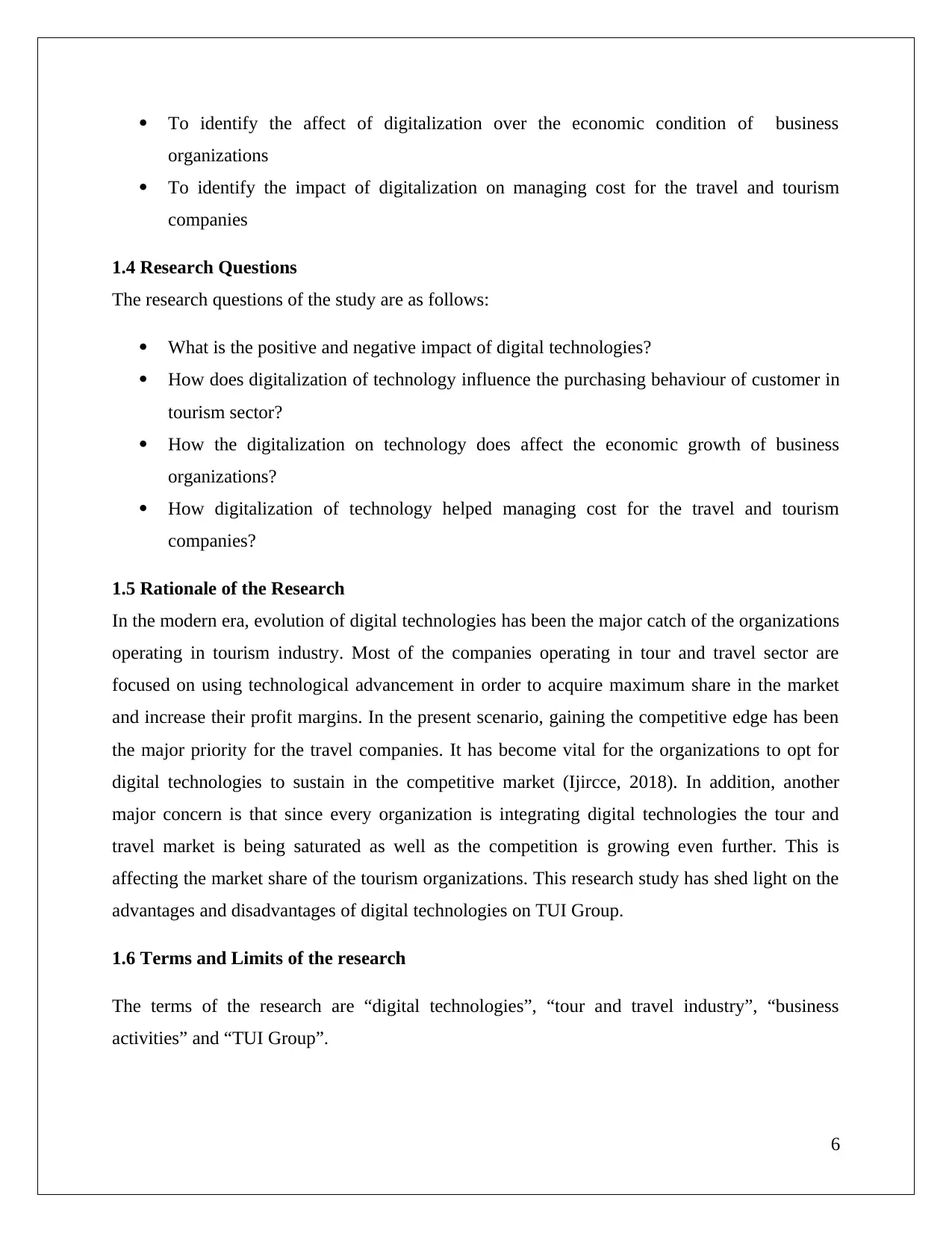
To identify the affect of digitalization over the economic condition of business
organizations
To identify the impact of digitalization on managing cost for the travel and tourism
companies
1.4 Research Questions
The research questions of the study are as follows:
What is the positive and negative impact of digital technologies?
How does digitalization of technology influence the purchasing behaviour of customer in
tourism sector?
How the digitalization on technology does affect the economic growth of business
organizations?
How digitalization of technology helped managing cost for the travel and tourism
companies?
1.5 Rationale of the Research
In the modern era, evolution of digital technologies has been the major catch of the organizations
operating in tourism industry. Most of the companies operating in tour and travel sector are
focused on using technological advancement in order to acquire maximum share in the market
and increase their profit margins. In the present scenario, gaining the competitive edge has been
the major priority for the travel companies. It has become vital for the organizations to opt for
digital technologies to sustain in the competitive market (Ijircce, 2018). In addition, another
major concern is that since every organization is integrating digital technologies the tour and
travel market is being saturated as well as the competition is growing even further. This is
affecting the market share of the tourism organizations. This research study has shed light on the
advantages and disadvantages of digital technologies on TUI Group.
1.6 Terms and Limits of the research
The terms of the research are “digital technologies”, “tour and travel industry”, “business
activities” and “TUI Group”.
6
organizations
To identify the impact of digitalization on managing cost for the travel and tourism
companies
1.4 Research Questions
The research questions of the study are as follows:
What is the positive and negative impact of digital technologies?
How does digitalization of technology influence the purchasing behaviour of customer in
tourism sector?
How the digitalization on technology does affect the economic growth of business
organizations?
How digitalization of technology helped managing cost for the travel and tourism
companies?
1.5 Rationale of the Research
In the modern era, evolution of digital technologies has been the major catch of the organizations
operating in tourism industry. Most of the companies operating in tour and travel sector are
focused on using technological advancement in order to acquire maximum share in the market
and increase their profit margins. In the present scenario, gaining the competitive edge has been
the major priority for the travel companies. It has become vital for the organizations to opt for
digital technologies to sustain in the competitive market (Ijircce, 2018). In addition, another
major concern is that since every organization is integrating digital technologies the tour and
travel market is being saturated as well as the competition is growing even further. This is
affecting the market share of the tourism organizations. This research study has shed light on the
advantages and disadvantages of digital technologies on TUI Group.
1.6 Terms and Limits of the research
The terms of the research are “digital technologies”, “tour and travel industry”, “business
activities” and “TUI Group”.
6

The research is limited geographically since the research is conducted based on TUI Group that
is one of the tourism companies in Germany.
1.7 Structure of the Research
Figure 1: Structure of the Research
(Source: Created by learner)
1.8 Summary
In this chapter, a brief introduction about the digital technologies and its impact on the business
organizations had been presented. Further, research aim, objectives, and questions have been
provided based on which the research will be conducted. This chapter also discusses the rationale
of the research study that shows the issues of digital technologies.
7
IntroductionDiscussion
is one of the tourism companies in Germany.
1.7 Structure of the Research
Figure 1: Structure of the Research
(Source: Created by learner)
1.8 Summary
In this chapter, a brief introduction about the digital technologies and its impact on the business
organizations had been presented. Further, research aim, objectives, and questions have been
provided based on which the research will be conducted. This chapter also discusses the rationale
of the research study that shows the issues of digital technologies.
7
IntroductionDiscussion
Secure Best Marks with AI Grader
Need help grading? Try our AI Grader for instant feedback on your assignments.
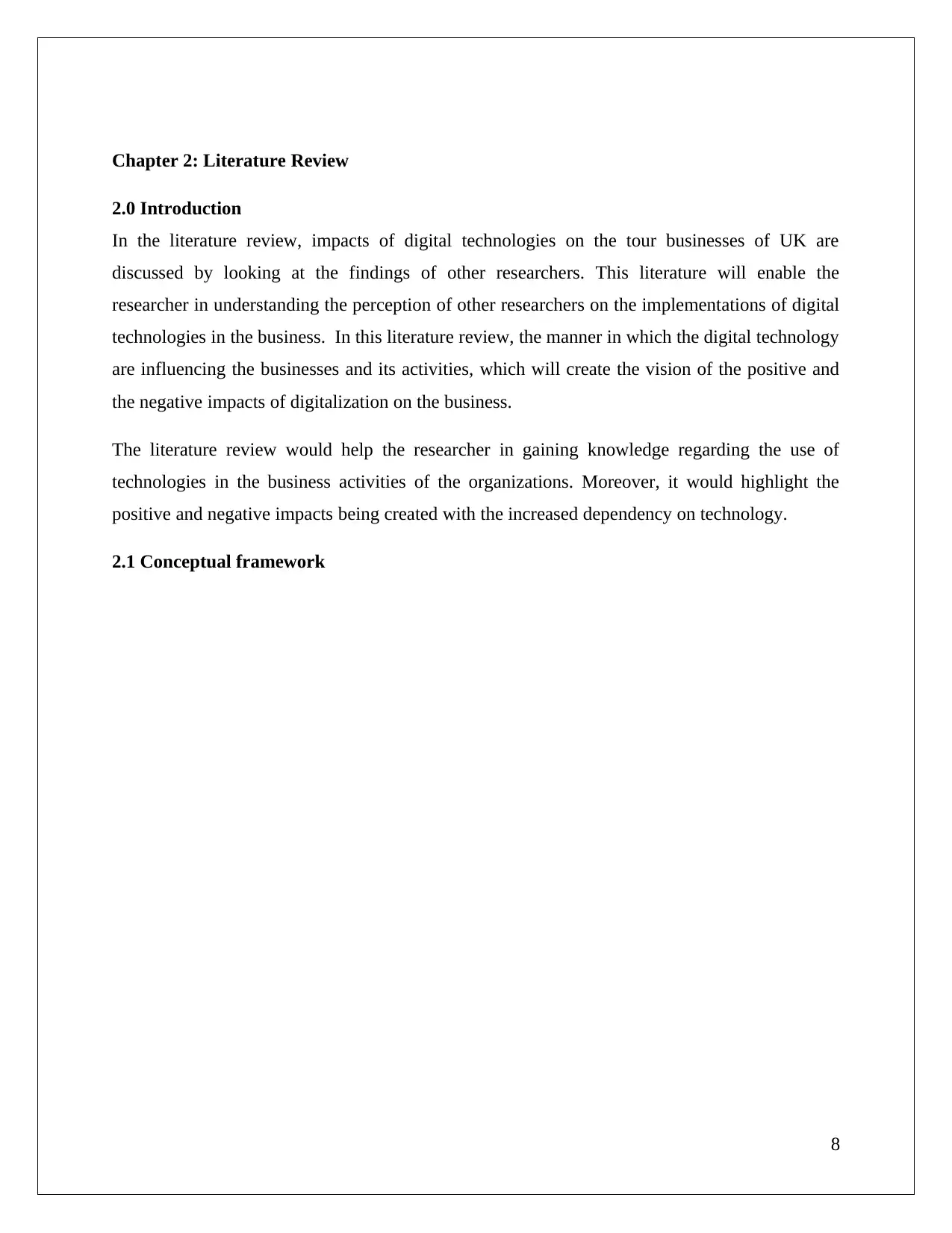
Chapter 2: Literature Review
2.0 Introduction
In the literature review, impacts of digital technologies on the tour businesses of UK are
discussed by looking at the findings of other researchers. This literature will enable the
researcher in understanding the perception of other researchers on the implementations of digital
technologies in the business. In this literature review, the manner in which the digital technology
are influencing the businesses and its activities, which will create the vision of the positive and
the negative impacts of digitalization on the business.
The literature review would help the researcher in gaining knowledge regarding the use of
technologies in the business activities of the organizations. Moreover, it would highlight the
positive and negative impacts being created with the increased dependency on technology.
2.1 Conceptual framework
8
2.0 Introduction
In the literature review, impacts of digital technologies on the tour businesses of UK are
discussed by looking at the findings of other researchers. This literature will enable the
researcher in understanding the perception of other researchers on the implementations of digital
technologies in the business. In this literature review, the manner in which the digital technology
are influencing the businesses and its activities, which will create the vision of the positive and
the negative impacts of digitalization on the business.
The literature review would help the researcher in gaining knowledge regarding the use of
technologies in the business activities of the organizations. Moreover, it would highlight the
positive and negative impacts being created with the increased dependency on technology.
2.1 Conceptual framework
8

Figure: Conceptual Framework
(Source: Created by the learner)
2.2 Latest digital technologies trends in the travel and tourism industry
IT is becoming an essential part for the businesses that are executing their activities in the
markets and this digital dependency is increasing at a fast pace. The organizations that are in the
tour operating businesses are relying more on these digital technologies like, IT, smart
application of mobiles and websites in order to process their business in an easier manner. As
mentioned by Kane, et al., (2015), digital technologies in organizational activities provides three
basic supports to the management, which are agility, digital options and entrepreneurial alertness
that help the businesses in designing their operations in a unique manner.
9
(Source: Created by the learner)
2.2 Latest digital technologies trends in the travel and tourism industry
IT is becoming an essential part for the businesses that are executing their activities in the
markets and this digital dependency is increasing at a fast pace. The organizations that are in the
tour operating businesses are relying more on these digital technologies like, IT, smart
application of mobiles and websites in order to process their business in an easier manner. As
mentioned by Kane, et al., (2015), digital technologies in organizational activities provides three
basic supports to the management, which are agility, digital options and entrepreneurial alertness
that help the businesses in designing their operations in a unique manner.
9
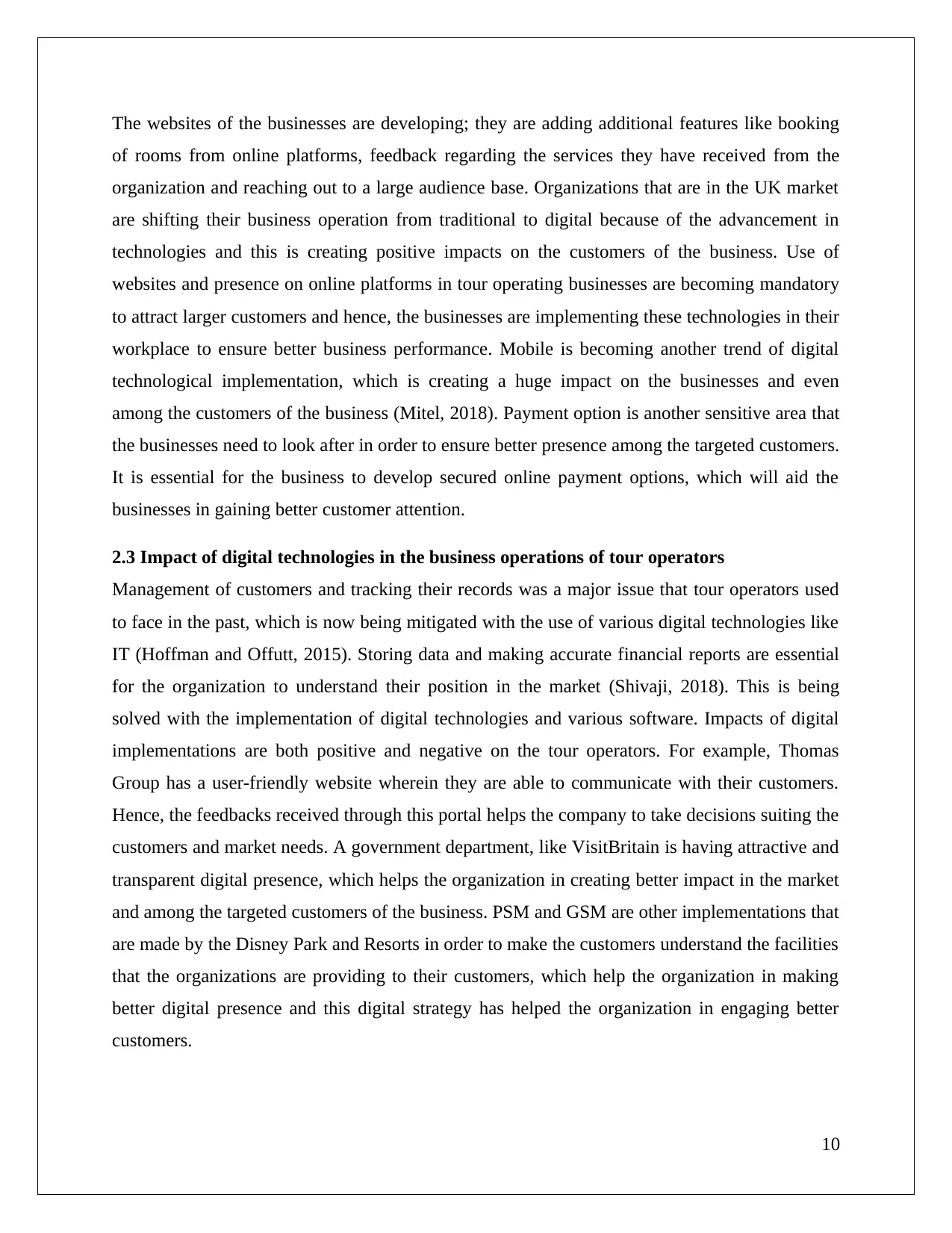
The websites of the businesses are developing; they are adding additional features like booking
of rooms from online platforms, feedback regarding the services they have received from the
organization and reaching out to a large audience base. Organizations that are in the UK market
are shifting their business operation from traditional to digital because of the advancement in
technologies and this is creating positive impacts on the customers of the business. Use of
websites and presence on online platforms in tour operating businesses are becoming mandatory
to attract larger customers and hence, the businesses are implementing these technologies in their
workplace to ensure better business performance. Mobile is becoming another trend of digital
technological implementation, which is creating a huge impact on the businesses and even
among the customers of the business (Mitel, 2018). Payment option is another sensitive area that
the businesses need to look after in order to ensure better presence among the targeted customers.
It is essential for the business to develop secured online payment options, which will aid the
businesses in gaining better customer attention.
2.3 Impact of digital technologies in the business operations of tour operators
Management of customers and tracking their records was a major issue that tour operators used
to face in the past, which is now being mitigated with the use of various digital technologies like
IT (Hoffman and Offutt, 2015). Storing data and making accurate financial reports are essential
for the organization to understand their position in the market (Shivaji, 2018). This is being
solved with the implementation of digital technologies and various software. Impacts of digital
implementations are both positive and negative on the tour operators. For example, Thomas
Group has a user-friendly website wherein they are able to communicate with their customers.
Hence, the feedbacks received through this portal helps the company to take decisions suiting the
customers and market needs. A government department, like VisitBritain is having attractive and
transparent digital presence, which helps the organization in creating better impact in the market
and among the targeted customers of the business. PSM and GSM are other implementations that
are made by the Disney Park and Resorts in order to make the customers understand the facilities
that the organizations are providing to their customers, which help the organization in making
better digital presence and this digital strategy has helped the organization in engaging better
customers.
10
of rooms from online platforms, feedback regarding the services they have received from the
organization and reaching out to a large audience base. Organizations that are in the UK market
are shifting their business operation from traditional to digital because of the advancement in
technologies and this is creating positive impacts on the customers of the business. Use of
websites and presence on online platforms in tour operating businesses are becoming mandatory
to attract larger customers and hence, the businesses are implementing these technologies in their
workplace to ensure better business performance. Mobile is becoming another trend of digital
technological implementation, which is creating a huge impact on the businesses and even
among the customers of the business (Mitel, 2018). Payment option is another sensitive area that
the businesses need to look after in order to ensure better presence among the targeted customers.
It is essential for the business to develop secured online payment options, which will aid the
businesses in gaining better customer attention.
2.3 Impact of digital technologies in the business operations of tour operators
Management of customers and tracking their records was a major issue that tour operators used
to face in the past, which is now being mitigated with the use of various digital technologies like
IT (Hoffman and Offutt, 2015). Storing data and making accurate financial reports are essential
for the organization to understand their position in the market (Shivaji, 2018). This is being
solved with the implementation of digital technologies and various software. Impacts of digital
implementations are both positive and negative on the tour operators. For example, Thomas
Group has a user-friendly website wherein they are able to communicate with their customers.
Hence, the feedbacks received through this portal helps the company to take decisions suiting the
customers and market needs. A government department, like VisitBritain is having attractive and
transparent digital presence, which helps the organization in creating better impact in the market
and among the targeted customers of the business. PSM and GSM are other implementations that
are made by the Disney Park and Resorts in order to make the customers understand the facilities
that the organizations are providing to their customers, which help the organization in making
better digital presence and this digital strategy has helped the organization in engaging better
customers.
10
Paraphrase This Document
Need a fresh take? Get an instant paraphrase of this document with our AI Paraphraser
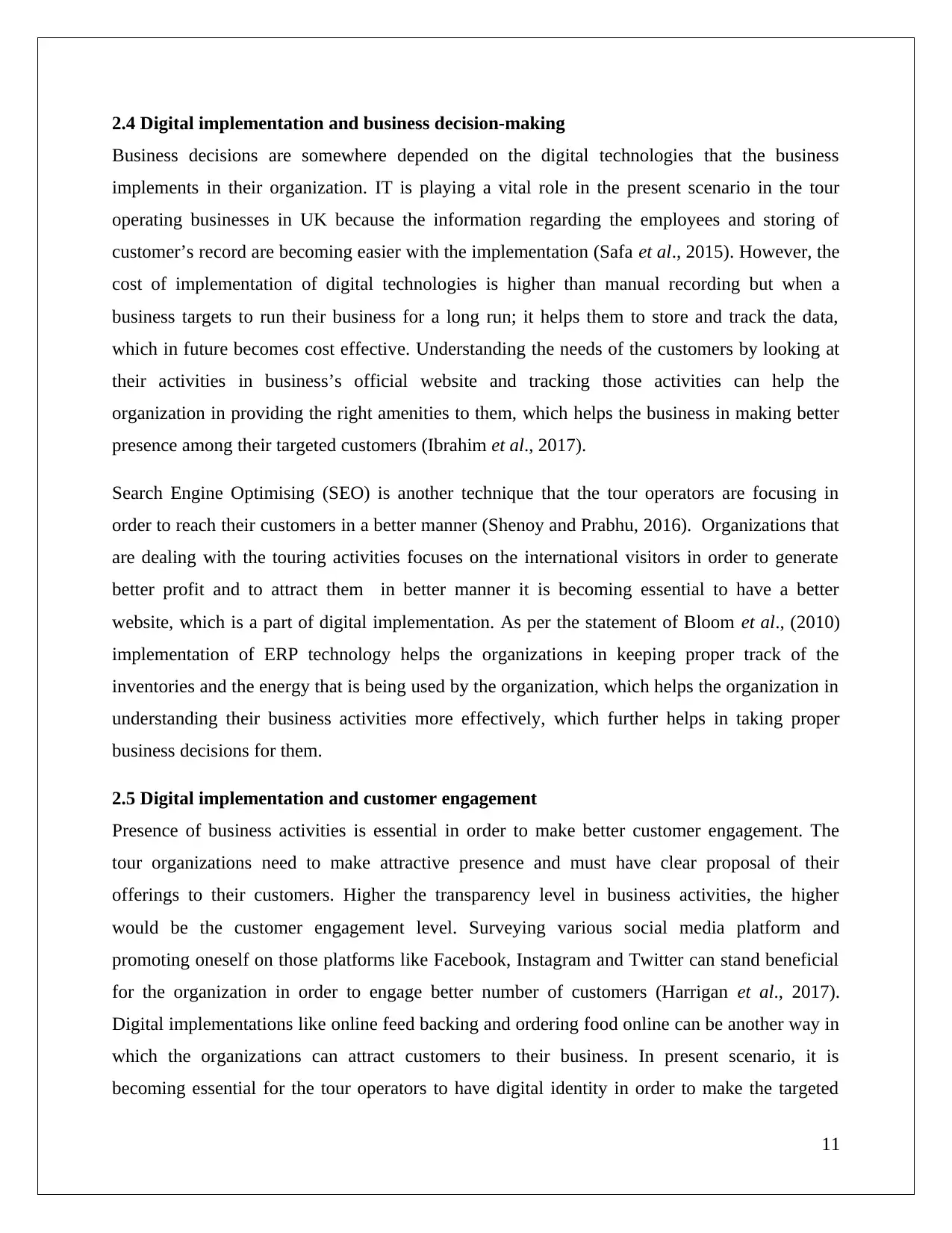
2.4 Digital implementation and business decision-making
Business decisions are somewhere depended on the digital technologies that the business
implements in their organization. IT is playing a vital role in the present scenario in the tour
operating businesses in UK because the information regarding the employees and storing of
customer’s record are becoming easier with the implementation (Safa et al., 2015). However, the
cost of implementation of digital technologies is higher than manual recording but when a
business targets to run their business for a long run; it helps them to store and track the data,
which in future becomes cost effective. Understanding the needs of the customers by looking at
their activities in business’s official website and tracking those activities can help the
organization in providing the right amenities to them, which helps the business in making better
presence among their targeted customers (Ibrahim et al., 2017).
Search Engine Optimising (SEO) is another technique that the tour operators are focusing in
order to reach their customers in a better manner (Shenoy and Prabhu, 2016). Organizations that
are dealing with the touring activities focuses on the international visitors in order to generate
better profit and to attract them in better manner it is becoming essential to have a better
website, which is a part of digital implementation. As per the statement of Bloom et al., (2010)
implementation of ERP technology helps the organizations in keeping proper track of the
inventories and the energy that is being used by the organization, which helps the organization in
understanding their business activities more effectively, which further helps in taking proper
business decisions for them.
2.5 Digital implementation and customer engagement
Presence of business activities is essential in order to make better customer engagement. The
tour organizations need to make attractive presence and must have clear proposal of their
offerings to their customers. Higher the transparency level in business activities, the higher
would be the customer engagement level. Surveying various social media platform and
promoting oneself on those platforms like Facebook, Instagram and Twitter can stand beneficial
for the organization in order to engage better number of customers (Harrigan et al., 2017).
Digital implementations like online feed backing and ordering food online can be another way in
which the organizations can attract customers to their business. In present scenario, it is
becoming essential for the tour operators to have digital identity in order to make the targeted
11
Business decisions are somewhere depended on the digital technologies that the business
implements in their organization. IT is playing a vital role in the present scenario in the tour
operating businesses in UK because the information regarding the employees and storing of
customer’s record are becoming easier with the implementation (Safa et al., 2015). However, the
cost of implementation of digital technologies is higher than manual recording but when a
business targets to run their business for a long run; it helps them to store and track the data,
which in future becomes cost effective. Understanding the needs of the customers by looking at
their activities in business’s official website and tracking those activities can help the
organization in providing the right amenities to them, which helps the business in making better
presence among their targeted customers (Ibrahim et al., 2017).
Search Engine Optimising (SEO) is another technique that the tour operators are focusing in
order to reach their customers in a better manner (Shenoy and Prabhu, 2016). Organizations that
are dealing with the touring activities focuses on the international visitors in order to generate
better profit and to attract them in better manner it is becoming essential to have a better
website, which is a part of digital implementation. As per the statement of Bloom et al., (2010)
implementation of ERP technology helps the organizations in keeping proper track of the
inventories and the energy that is being used by the organization, which helps the organization in
understanding their business activities more effectively, which further helps in taking proper
business decisions for them.
2.5 Digital implementation and customer engagement
Presence of business activities is essential in order to make better customer engagement. The
tour organizations need to make attractive presence and must have clear proposal of their
offerings to their customers. Higher the transparency level in business activities, the higher
would be the customer engagement level. Surveying various social media platform and
promoting oneself on those platforms like Facebook, Instagram and Twitter can stand beneficial
for the organization in order to engage better number of customers (Harrigan et al., 2017).
Digital implementations like online feed backing and ordering food online can be another way in
which the organizations can attract customers to their business. In present scenario, it is
becoming essential for the tour operators to have digital identity in order to make the targeted
11
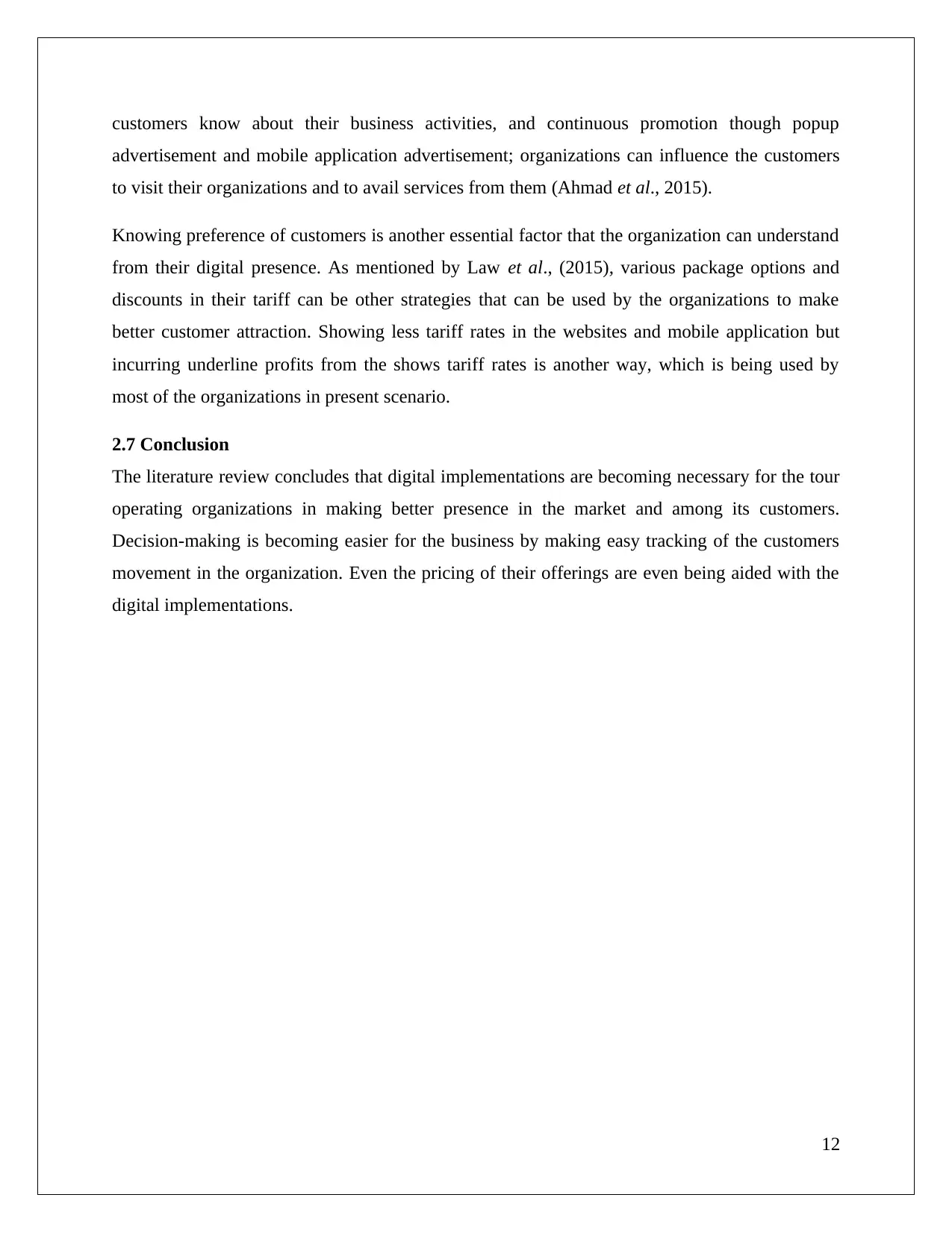
customers know about their business activities, and continuous promotion though popup
advertisement and mobile application advertisement; organizations can influence the customers
to visit their organizations and to avail services from them (Ahmad et al., 2015).
Knowing preference of customers is another essential factor that the organization can understand
from their digital presence. As mentioned by Law et al., (2015), various package options and
discounts in their tariff can be other strategies that can be used by the organizations to make
better customer attraction. Showing less tariff rates in the websites and mobile application but
incurring underline profits from the shows tariff rates is another way, which is being used by
most of the organizations in present scenario.
2.7 Conclusion
The literature review concludes that digital implementations are becoming necessary for the tour
operating organizations in making better presence in the market and among its customers.
Decision-making is becoming easier for the business by making easy tracking of the customers
movement in the organization. Even the pricing of their offerings are even being aided with the
digital implementations.
12
advertisement and mobile application advertisement; organizations can influence the customers
to visit their organizations and to avail services from them (Ahmad et al., 2015).
Knowing preference of customers is another essential factor that the organization can understand
from their digital presence. As mentioned by Law et al., (2015), various package options and
discounts in their tariff can be other strategies that can be used by the organizations to make
better customer attraction. Showing less tariff rates in the websites and mobile application but
incurring underline profits from the shows tariff rates is another way, which is being used by
most of the organizations in present scenario.
2.7 Conclusion
The literature review concludes that digital implementations are becoming necessary for the tour
operating organizations in making better presence in the market and among its customers.
Decision-making is becoming easier for the business by making easy tracking of the customers
movement in the organization. Even the pricing of their offerings are even being aided with the
digital implementations.
12
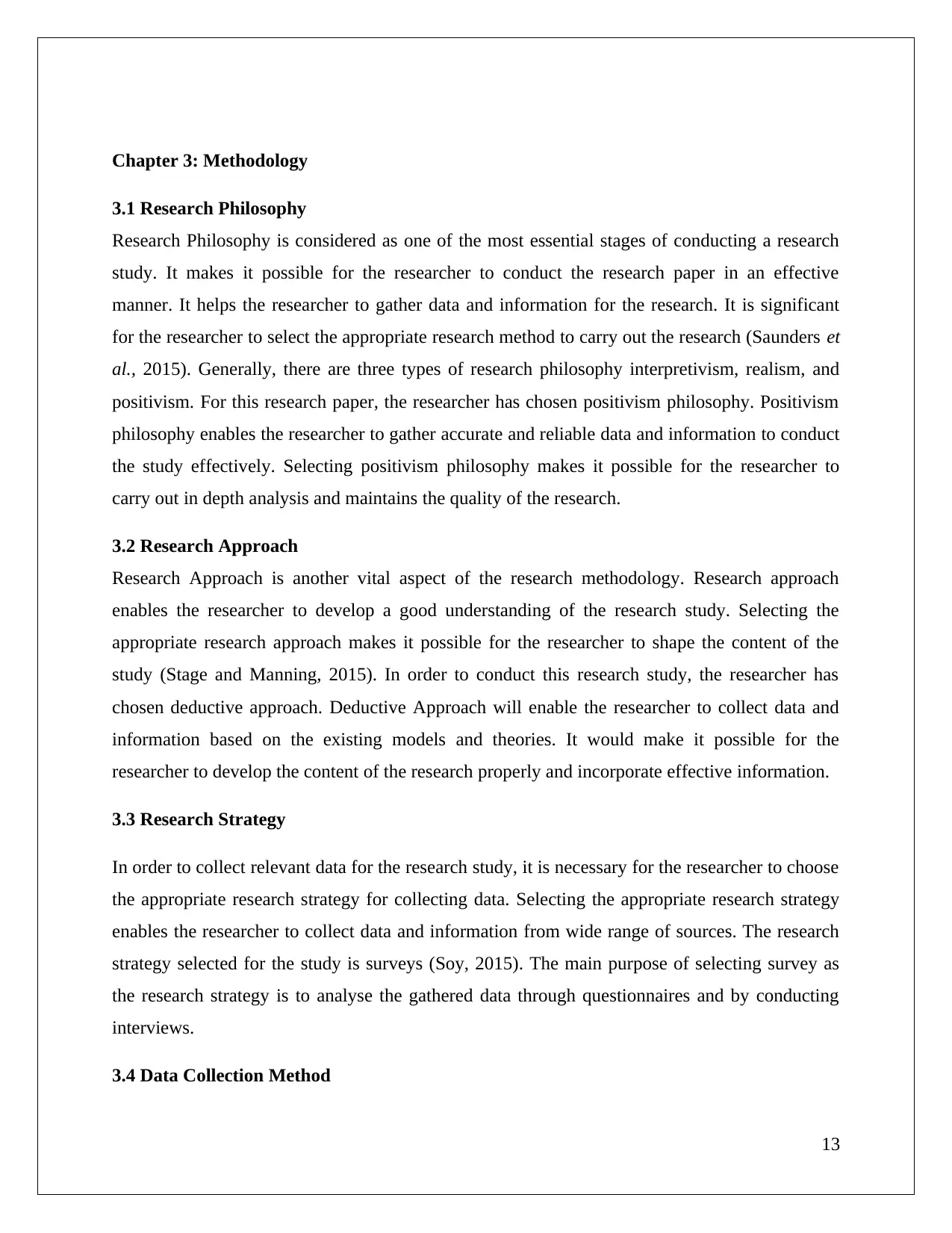
Chapter 3: Methodology
3.1 Research Philosophy
Research Philosophy is considered as one of the most essential stages of conducting a research
study. It makes it possible for the researcher to conduct the research paper in an effective
manner. It helps the researcher to gather data and information for the research. It is significant
for the researcher to select the appropriate research method to carry out the research (Saunders et
al., 2015). Generally, there are three types of research philosophy interpretivism, realism, and
positivism. For this research paper, the researcher has chosen positivism philosophy. Positivism
philosophy enables the researcher to gather accurate and reliable data and information to conduct
the study effectively. Selecting positivism philosophy makes it possible for the researcher to
carry out in depth analysis and maintains the quality of the research.
3.2 Research Approach
Research Approach is another vital aspect of the research methodology. Research approach
enables the researcher to develop a good understanding of the research study. Selecting the
appropriate research approach makes it possible for the researcher to shape the content of the
study (Stage and Manning, 2015). In order to conduct this research study, the researcher has
chosen deductive approach. Deductive Approach will enable the researcher to collect data and
information based on the existing models and theories. It would make it possible for the
researcher to develop the content of the research properly and incorporate effective information.
3.3 Research Strategy
In order to collect relevant data for the research study, it is necessary for the researcher to choose
the appropriate research strategy for collecting data. Selecting the appropriate research strategy
enables the researcher to collect data and information from wide range of sources. The research
strategy selected for the study is surveys (Soy, 2015). The main purpose of selecting survey as
the research strategy is to analyse the gathered data through questionnaires and by conducting
interviews.
3.4 Data Collection Method
13
3.1 Research Philosophy
Research Philosophy is considered as one of the most essential stages of conducting a research
study. It makes it possible for the researcher to conduct the research paper in an effective
manner. It helps the researcher to gather data and information for the research. It is significant
for the researcher to select the appropriate research method to carry out the research (Saunders et
al., 2015). Generally, there are three types of research philosophy interpretivism, realism, and
positivism. For this research paper, the researcher has chosen positivism philosophy. Positivism
philosophy enables the researcher to gather accurate and reliable data and information to conduct
the study effectively. Selecting positivism philosophy makes it possible for the researcher to
carry out in depth analysis and maintains the quality of the research.
3.2 Research Approach
Research Approach is another vital aspect of the research methodology. Research approach
enables the researcher to develop a good understanding of the research study. Selecting the
appropriate research approach makes it possible for the researcher to shape the content of the
study (Stage and Manning, 2015). In order to conduct this research study, the researcher has
chosen deductive approach. Deductive Approach will enable the researcher to collect data and
information based on the existing models and theories. It would make it possible for the
researcher to develop the content of the research properly and incorporate effective information.
3.3 Research Strategy
In order to collect relevant data for the research study, it is necessary for the researcher to choose
the appropriate research strategy for collecting data. Selecting the appropriate research strategy
enables the researcher to collect data and information from wide range of sources. The research
strategy selected for the study is surveys (Soy, 2015). The main purpose of selecting survey as
the research strategy is to analyse the gathered data through questionnaires and by conducting
interviews.
3.4 Data Collection Method
13
Secure Best Marks with AI Grader
Need help grading? Try our AI Grader for instant feedback on your assignments.
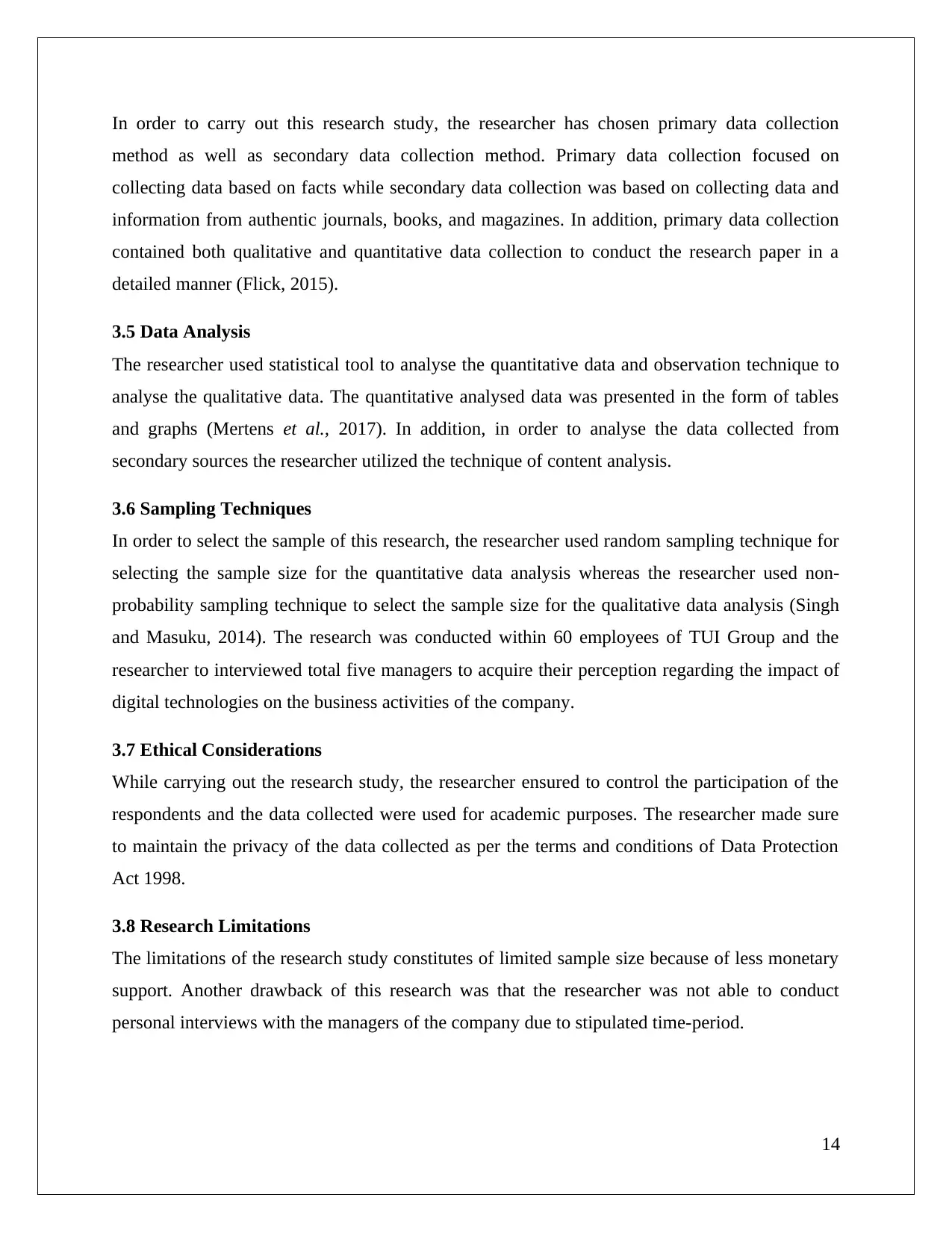
In order to carry out this research study, the researcher has chosen primary data collection
method as well as secondary data collection method. Primary data collection focused on
collecting data based on facts while secondary data collection was based on collecting data and
information from authentic journals, books, and magazines. In addition, primary data collection
contained both qualitative and quantitative data collection to conduct the research paper in a
detailed manner (Flick, 2015).
3.5 Data Analysis
The researcher used statistical tool to analyse the quantitative data and observation technique to
analyse the qualitative data. The quantitative analysed data was presented in the form of tables
and graphs (Mertens et al., 2017). In addition, in order to analyse the data collected from
secondary sources the researcher utilized the technique of content analysis.
3.6 Sampling Techniques
In order to select the sample of this research, the researcher used random sampling technique for
selecting the sample size for the quantitative data analysis whereas the researcher used non-
probability sampling technique to select the sample size for the qualitative data analysis (Singh
and Masuku, 2014). The research was conducted within 60 employees of TUI Group and the
researcher to interviewed total five managers to acquire their perception regarding the impact of
digital technologies on the business activities of the company.
3.7 Ethical Considerations
While carrying out the research study, the researcher ensured to control the participation of the
respondents and the data collected were used for academic purposes. The researcher made sure
to maintain the privacy of the data collected as per the terms and conditions of Data Protection
Act 1998.
3.8 Research Limitations
The limitations of the research study constitutes of limited sample size because of less monetary
support. Another drawback of this research was that the researcher was not able to conduct
personal interviews with the managers of the company due to stipulated time-period.
14
method as well as secondary data collection method. Primary data collection focused on
collecting data based on facts while secondary data collection was based on collecting data and
information from authentic journals, books, and magazines. In addition, primary data collection
contained both qualitative and quantitative data collection to conduct the research paper in a
detailed manner (Flick, 2015).
3.5 Data Analysis
The researcher used statistical tool to analyse the quantitative data and observation technique to
analyse the qualitative data. The quantitative analysed data was presented in the form of tables
and graphs (Mertens et al., 2017). In addition, in order to analyse the data collected from
secondary sources the researcher utilized the technique of content analysis.
3.6 Sampling Techniques
In order to select the sample of this research, the researcher used random sampling technique for
selecting the sample size for the quantitative data analysis whereas the researcher used non-
probability sampling technique to select the sample size for the qualitative data analysis (Singh
and Masuku, 2014). The research was conducted within 60 employees of TUI Group and the
researcher to interviewed total five managers to acquire their perception regarding the impact of
digital technologies on the business activities of the company.
3.7 Ethical Considerations
While carrying out the research study, the researcher ensured to control the participation of the
respondents and the data collected were used for academic purposes. The researcher made sure
to maintain the privacy of the data collected as per the terms and conditions of Data Protection
Act 1998.
3.8 Research Limitations
The limitations of the research study constitutes of limited sample size because of less monetary
support. Another drawback of this research was that the researcher was not able to conduct
personal interviews with the managers of the company due to stipulated time-period.
14
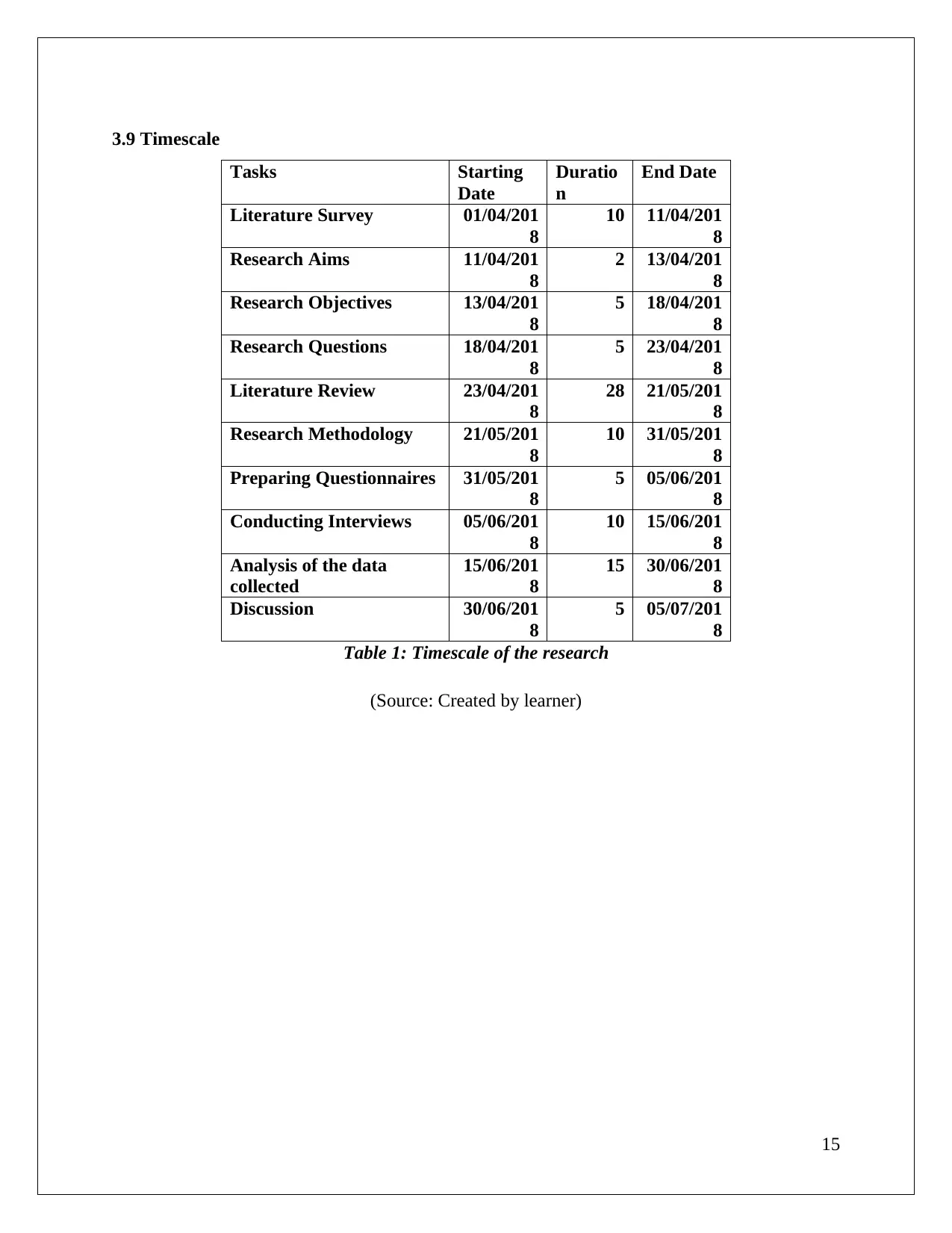
3.9 Timescale
Tasks Starting
Date
Duratio
n
End Date
Literature Survey 01/04/201
8
10 11/04/201
8
Research Aims 11/04/201
8
2 13/04/201
8
Research Objectives 13/04/201
8
5 18/04/201
8
Research Questions 18/04/201
8
5 23/04/201
8
Literature Review 23/04/201
8
28 21/05/201
8
Research Methodology 21/05/201
8
10 31/05/201
8
Preparing Questionnaires 31/05/201
8
5 05/06/201
8
Conducting Interviews 05/06/201
8
10 15/06/201
8
Analysis of the data
collected
15/06/201
8
15 30/06/201
8
Discussion 30/06/201
8
5 05/07/201
8
Table 1: Timescale of the research
(Source: Created by learner)
15
Tasks Starting
Date
Duratio
n
End Date
Literature Survey 01/04/201
8
10 11/04/201
8
Research Aims 11/04/201
8
2 13/04/201
8
Research Objectives 13/04/201
8
5 18/04/201
8
Research Questions 18/04/201
8
5 23/04/201
8
Literature Review 23/04/201
8
28 21/05/201
8
Research Methodology 21/05/201
8
10 31/05/201
8
Preparing Questionnaires 31/05/201
8
5 05/06/201
8
Conducting Interviews 05/06/201
8
10 15/06/201
8
Analysis of the data
collected
15/06/201
8
15 30/06/201
8
Discussion 30/06/201
8
5 05/07/201
8
Table 1: Timescale of the research
(Source: Created by learner)
15
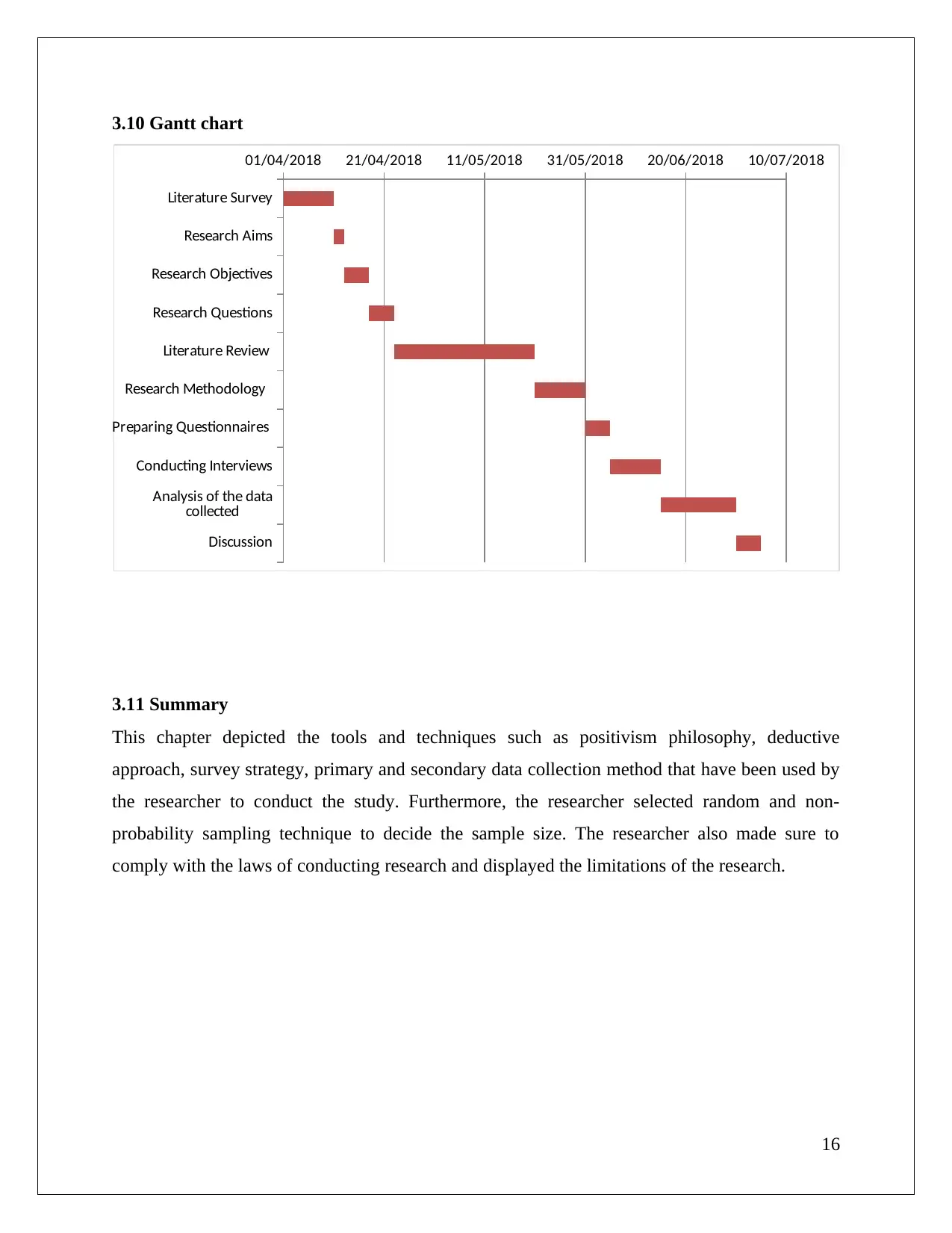
3.10 Gantt chart
Literature Survey
Research Aims
Research Objectives
Research Questions
Literature Review
Research Methodology
Preparing Questionnaires
Conducting Interviews
Analysis of the data
collected
Discussion
01/04/2018 21/04/2018 11/05/2018 31/05/2018 20/06/2018 10/07/2018
3.11 Summary
This chapter depicted the tools and techniques such as positivism philosophy, deductive
approach, survey strategy, primary and secondary data collection method that have been used by
the researcher to conduct the study. Furthermore, the researcher selected random and non-
probability sampling technique to decide the sample size. The researcher also made sure to
comply with the laws of conducting research and displayed the limitations of the research.
16
Literature Survey
Research Aims
Research Objectives
Research Questions
Literature Review
Research Methodology
Preparing Questionnaires
Conducting Interviews
Analysis of the data
collected
Discussion
01/04/2018 21/04/2018 11/05/2018 31/05/2018 20/06/2018 10/07/2018
3.11 Summary
This chapter depicted the tools and techniques such as positivism philosophy, deductive
approach, survey strategy, primary and secondary data collection method that have been used by
the researcher to conduct the study. Furthermore, the researcher selected random and non-
probability sampling technique to decide the sample size. The researcher also made sure to
comply with the laws of conducting research and displayed the limitations of the research.
16
Paraphrase This Document
Need a fresh take? Get an instant paraphrase of this document with our AI Paraphraser
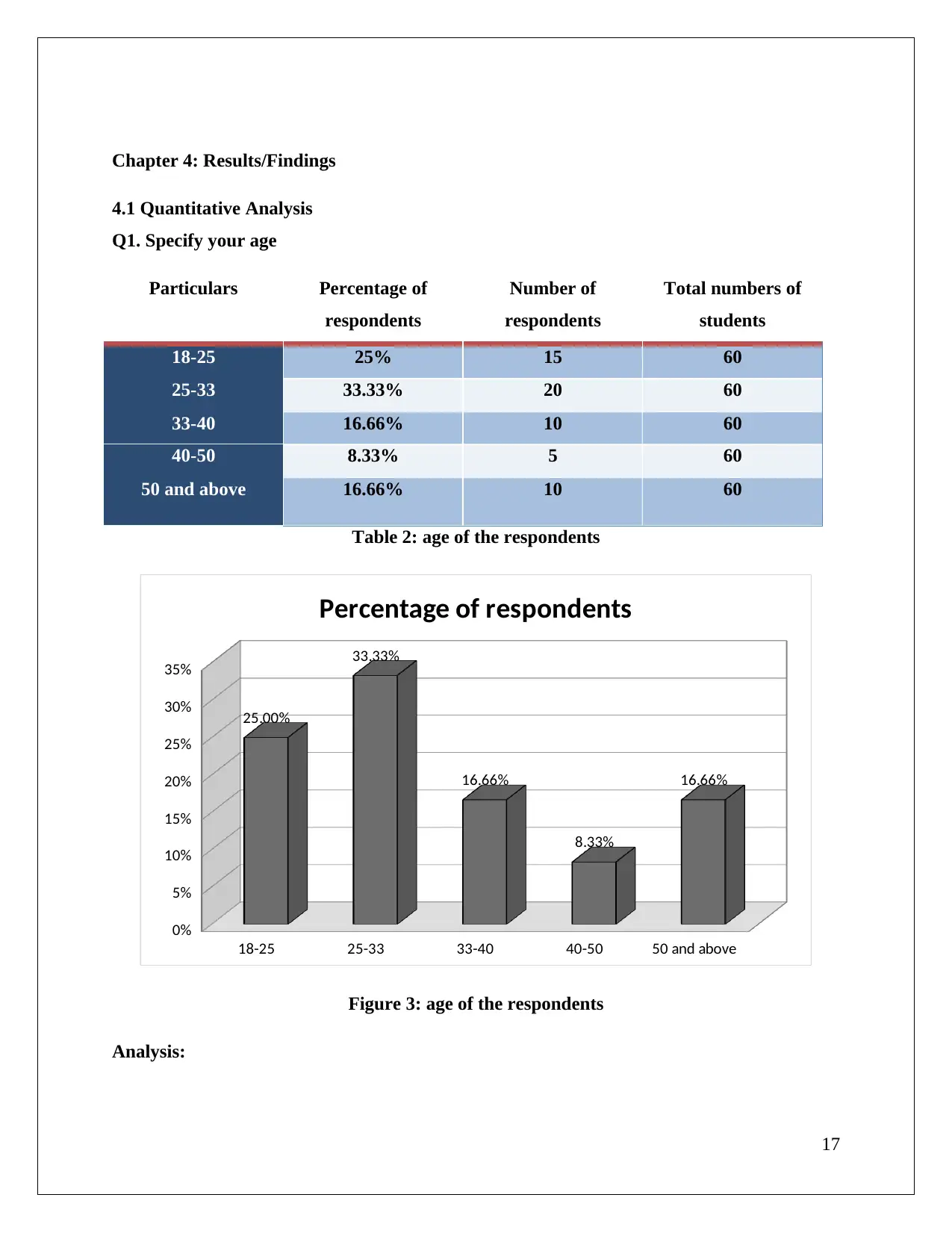
Chapter 4: Results/Findings
4.1 Quantitative Analysis
Q1. Specify your age
Particulars Percentage of
respondents
Number of
respondents
Total numbers of
students
18-25 25% 15 60
25-33 33.33% 20 60
33-40 16.66% 10 60
40-50 8.33% 5 60
50 and above 16.66% 10 60
Table 2: age of the respondents
18-25 25-33 33-40 40-50 50 and above
0%
5%
10%
15%
20%
25%
30%
35%
25.00%
33.33%
16.66%
8.33%
16.66%
Percentage of respondents
Figure 3: age of the respondents
Analysis:
17
4.1 Quantitative Analysis
Q1. Specify your age
Particulars Percentage of
respondents
Number of
respondents
Total numbers of
students
18-25 25% 15 60
25-33 33.33% 20 60
33-40 16.66% 10 60
40-50 8.33% 5 60
50 and above 16.66% 10 60
Table 2: age of the respondents
18-25 25-33 33-40 40-50 50 and above
0%
5%
10%
15%
20%
25%
30%
35%
25.00%
33.33%
16.66%
8.33%
16.66%
Percentage of respondents
Figure 3: age of the respondents
Analysis:
17

According to the details provided in the above figure, it can be seen that most of the respondents
belonged from age group 25-33 and 18-25. On the contrary, percentage of respondents from age
group 33-40 and 50 above were identical and just 8.33% of the respondents belonged from age
group 40-50. Thus, it could be stated that the respondents from age group 25-33 were the most
active during the survey.
Q2. What are the digital technologies integrated within TUI Group?
Particulars Percentage of
respondents
Number of
respondents
Total numbers of
students
Data Warehouse 16.66% 10 60
Cloud Computing 25% 15 60
ERP 41.66% 25 60
Artificial
Intelligence
16.66% 10 60
Others 0% 0 60
Table 3: digital technologies integrated within TUI Group
Data
Warehouse Cloud
Computing ERP Artificial
Intelligence Others
0.00%
5.00%
10.00%
15.00%
20.00%
25.00%
30.00%
35.00%
40.00%
45.00%
17%
25%
42%
17%
0%
Percentage of respondents
Figure 4: digital technologies integrated within TUI Group
18
belonged from age group 25-33 and 18-25. On the contrary, percentage of respondents from age
group 33-40 and 50 above were identical and just 8.33% of the respondents belonged from age
group 40-50. Thus, it could be stated that the respondents from age group 25-33 were the most
active during the survey.
Q2. What are the digital technologies integrated within TUI Group?
Particulars Percentage of
respondents
Number of
respondents
Total numbers of
students
Data Warehouse 16.66% 10 60
Cloud Computing 25% 15 60
ERP 41.66% 25 60
Artificial
Intelligence
16.66% 10 60
Others 0% 0 60
Table 3: digital technologies integrated within TUI Group
Data
Warehouse Cloud
Computing ERP Artificial
Intelligence Others
0.00%
5.00%
10.00%
15.00%
20.00%
25.00%
30.00%
35.00%
40.00%
45.00%
17%
25%
42%
17%
0%
Percentage of respondents
Figure 4: digital technologies integrated within TUI Group
18
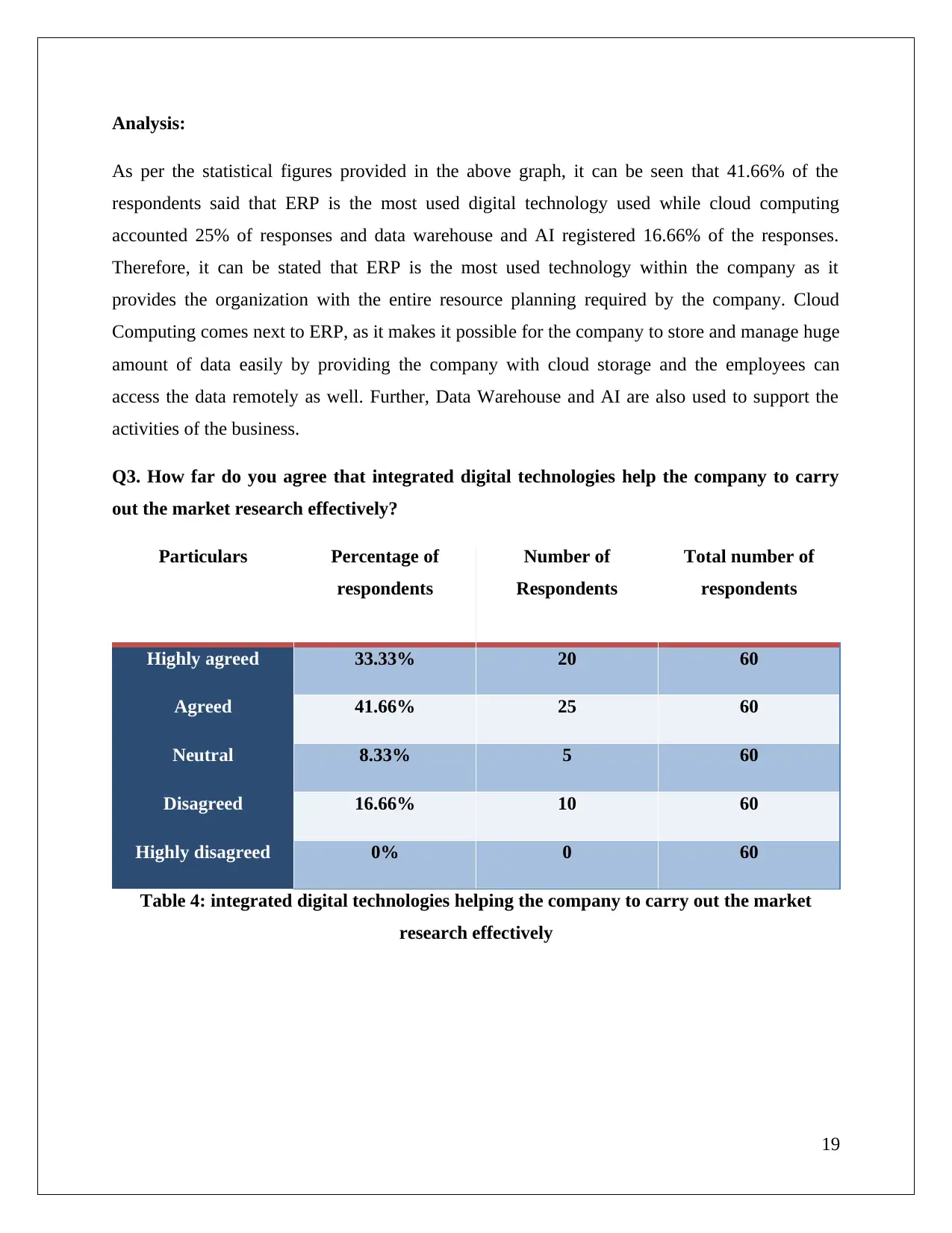
Analysis:
As per the statistical figures provided in the above graph, it can be seen that 41.66% of the
respondents said that ERP is the most used digital technology used while cloud computing
accounted 25% of responses and data warehouse and AI registered 16.66% of the responses.
Therefore, it can be stated that ERP is the most used technology within the company as it
provides the organization with the entire resource planning required by the company. Cloud
Computing comes next to ERP, as it makes it possible for the company to store and manage huge
amount of data easily by providing the company with cloud storage and the employees can
access the data remotely as well. Further, Data Warehouse and AI are also used to support the
activities of the business.
Q3. How far do you agree that integrated digital technologies help the company to carry
out the market research effectively?
Particulars Percentage of
respondents
Number of
Respondents
Total number of
respondents
Highly agreed 33.33% 20 60
Agreed 41.66% 25 60
Neutral 8.33% 5 60
Disagreed 16.66% 10 60
Highly disagreed 0% 0 60
Table 4: integrated digital technologies helping the company to carry out the market
research effectively
19
As per the statistical figures provided in the above graph, it can be seen that 41.66% of the
respondents said that ERP is the most used digital technology used while cloud computing
accounted 25% of responses and data warehouse and AI registered 16.66% of the responses.
Therefore, it can be stated that ERP is the most used technology within the company as it
provides the organization with the entire resource planning required by the company. Cloud
Computing comes next to ERP, as it makes it possible for the company to store and manage huge
amount of data easily by providing the company with cloud storage and the employees can
access the data remotely as well. Further, Data Warehouse and AI are also used to support the
activities of the business.
Q3. How far do you agree that integrated digital technologies help the company to carry
out the market research effectively?
Particulars Percentage of
respondents
Number of
Respondents
Total number of
respondents
Highly agreed 33.33% 20 60
Agreed 41.66% 25 60
Neutral 8.33% 5 60
Disagreed 16.66% 10 60
Highly disagreed 0% 0 60
Table 4: integrated digital technologies helping the company to carry out the market
research effectively
19
Secure Best Marks with AI Grader
Need help grading? Try our AI Grader for instant feedback on your assignments.

Highly agreed Agreed Neutral Disagreed Highly
disagreed
0.00%
5.00%
10.00%
15.00%
20.00%
25.00%
30.00%
35.00%
40.00%
45.00%
33.33%
41.66%
8.33%
16.66%
0.00%
Percentage of respondents
Figure 5: integrated digital technologies helping the company to carry out the market
research effectively
Analysis:
From the data provided in the above figure, it can be seen that approximately 75% of the total
respondents have agreed with the point that integrated digital technologies help the company to
carry out the market research effectively while 8.33% have given neutral responses and 16.66%
respondents have disagreed. Thus, it can be said that the integration of several technologies
within the organization enhances their effectiveness in researching the market. With the help of
integrated technologies, the company can look upon various ways to research the market.
Q4. How far do you agree that integrated digital technologies help the employees to carry
out their respective tasks effectively?
Particulars Percentage of
respondents
Number of
Respondents
Total number of
respondents
Highly agreed 41.66% 25 60
Agreed 25% 15 60
20
disagreed
0.00%
5.00%
10.00%
15.00%
20.00%
25.00%
30.00%
35.00%
40.00%
45.00%
33.33%
41.66%
8.33%
16.66%
0.00%
Percentage of respondents
Figure 5: integrated digital technologies helping the company to carry out the market
research effectively
Analysis:
From the data provided in the above figure, it can be seen that approximately 75% of the total
respondents have agreed with the point that integrated digital technologies help the company to
carry out the market research effectively while 8.33% have given neutral responses and 16.66%
respondents have disagreed. Thus, it can be said that the integration of several technologies
within the organization enhances their effectiveness in researching the market. With the help of
integrated technologies, the company can look upon various ways to research the market.
Q4. How far do you agree that integrated digital technologies help the employees to carry
out their respective tasks effectively?
Particulars Percentage of
respondents
Number of
Respondents
Total number of
respondents
Highly agreed 41.66% 25 60
Agreed 25% 15 60
20
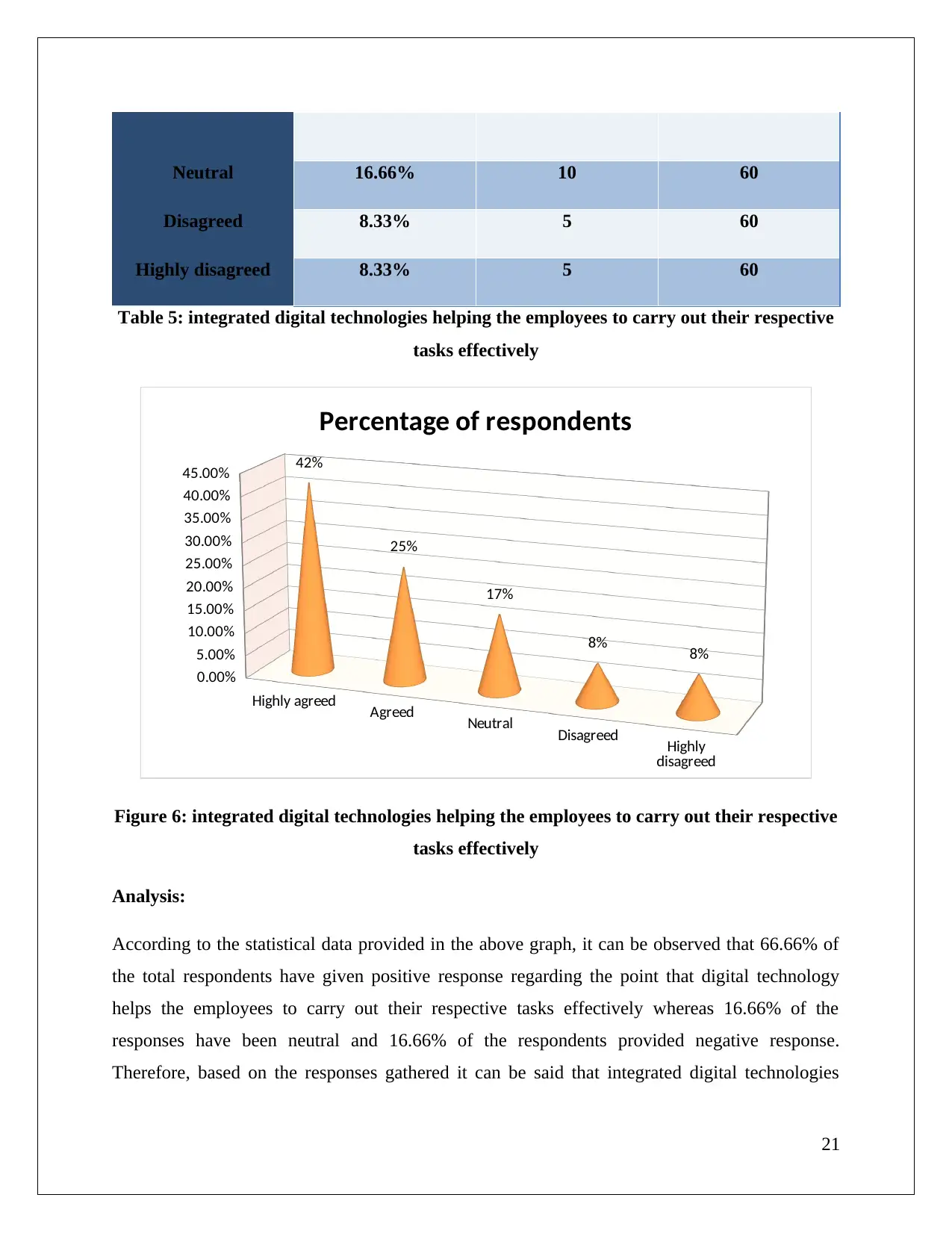
Neutral 16.66% 10 60
Disagreed 8.33% 5 60
Highly disagreed 8.33% 5 60
Table 5: integrated digital technologies helping the employees to carry out their respective
tasks effectively
Highly agreed Agreed Neutral Disagreed Highly
disagreed
0.00%
5.00%
10.00%
15.00%
20.00%
25.00%
30.00%
35.00%
40.00%
45.00% 42%
25%
17%
8% 8%
Percentage of respondents
Figure 6: integrated digital technologies helping the employees to carry out their respective
tasks effectively
Analysis:
According to the statistical data provided in the above graph, it can be observed that 66.66% of
the total respondents have given positive response regarding the point that digital technology
helps the employees to carry out their respective tasks effectively whereas 16.66% of the
responses have been neutral and 16.66% of the respondents provided negative response.
Therefore, based on the responses gathered it can be said that integrated digital technologies
21
Disagreed 8.33% 5 60
Highly disagreed 8.33% 5 60
Table 5: integrated digital technologies helping the employees to carry out their respective
tasks effectively
Highly agreed Agreed Neutral Disagreed Highly
disagreed
0.00%
5.00%
10.00%
15.00%
20.00%
25.00%
30.00%
35.00%
40.00%
45.00% 42%
25%
17%
8% 8%
Percentage of respondents
Figure 6: integrated digital technologies helping the employees to carry out their respective
tasks effectively
Analysis:
According to the statistical data provided in the above graph, it can be observed that 66.66% of
the total respondents have given positive response regarding the point that digital technology
helps the employees to carry out their respective tasks effectively whereas 16.66% of the
responses have been neutral and 16.66% of the respondents provided negative response.
Therefore, based on the responses gathered it can be said that integrated digital technologies
21
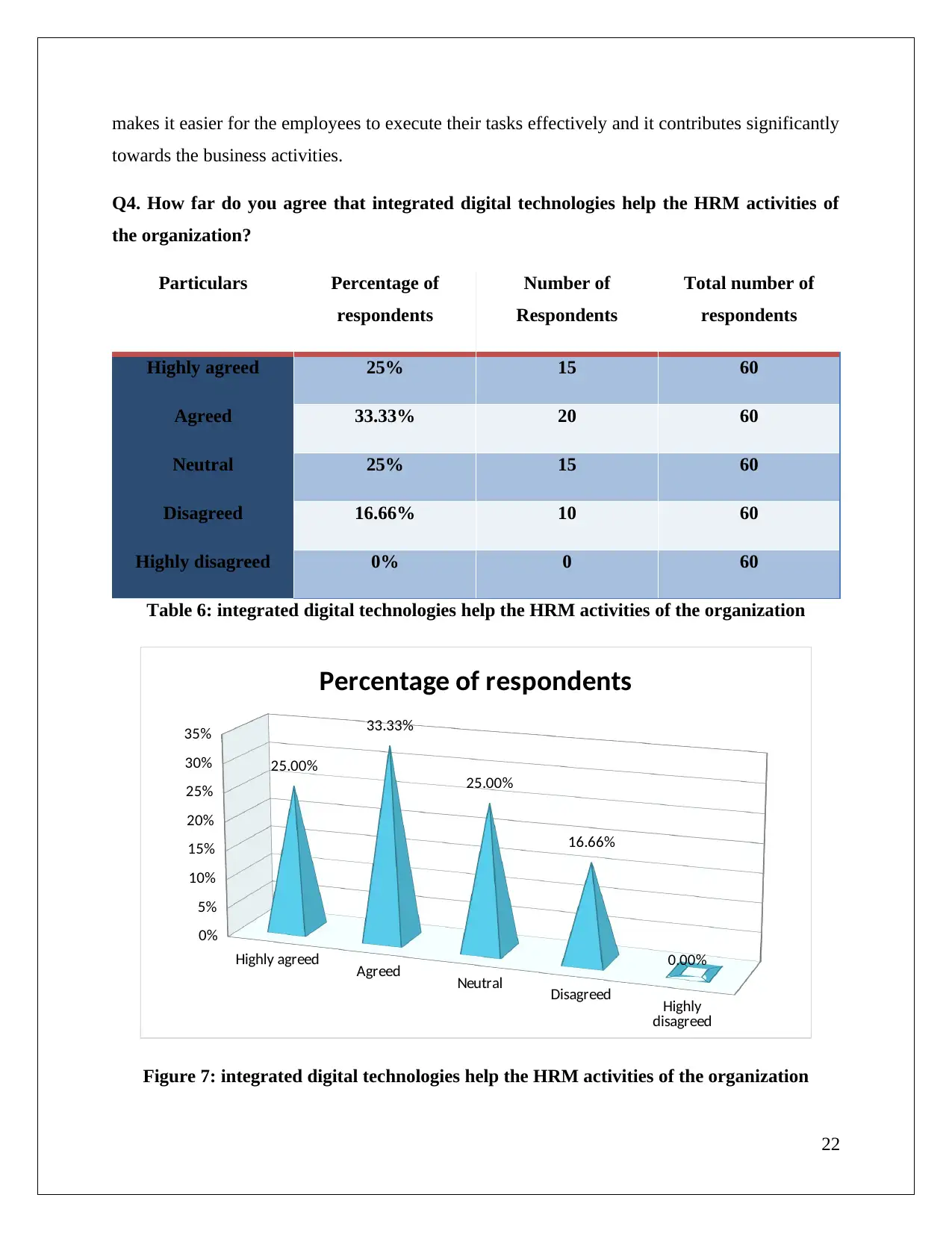
makes it easier for the employees to execute their tasks effectively and it contributes significantly
towards the business activities.
Q4. How far do you agree that integrated digital technologies help the HRM activities of
the organization?
Particulars Percentage of
respondents
Number of
Respondents
Total number of
respondents
Highly agreed 25% 15 60
Agreed 33.33% 20 60
Neutral 25% 15 60
Disagreed 16.66% 10 60
Highly disagreed 0% 0 60
Table 6: integrated digital technologies help the HRM activities of the organization
Highly agreed Agreed Neutral Disagreed Highly
disagreed
0%
5%
10%
15%
20%
25%
30%
35%
25.00%
33.33%
25.00%
16.66%
0.00%
Percentage of respondents
Figure 7: integrated digital technologies help the HRM activities of the organization
22
towards the business activities.
Q4. How far do you agree that integrated digital technologies help the HRM activities of
the organization?
Particulars Percentage of
respondents
Number of
Respondents
Total number of
respondents
Highly agreed 25% 15 60
Agreed 33.33% 20 60
Neutral 25% 15 60
Disagreed 16.66% 10 60
Highly disagreed 0% 0 60
Table 6: integrated digital technologies help the HRM activities of the organization
Highly agreed Agreed Neutral Disagreed Highly
disagreed
0%
5%
10%
15%
20%
25%
30%
35%
25.00%
33.33%
25.00%
16.66%
0.00%
Percentage of respondents
Figure 7: integrated digital technologies help the HRM activities of the organization
22
Paraphrase This Document
Need a fresh take? Get an instant paraphrase of this document with our AI Paraphraser
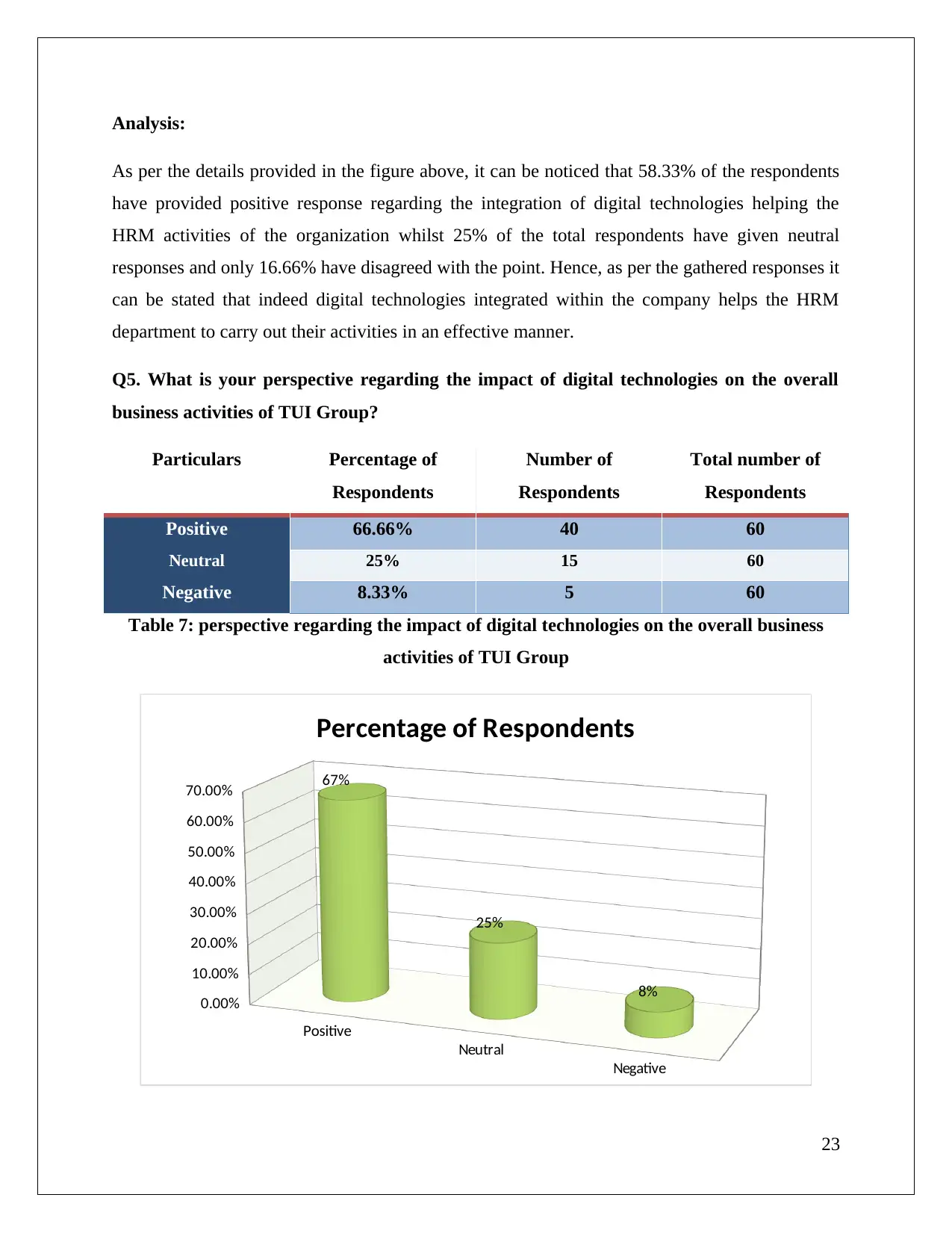
Analysis:
As per the details provided in the figure above, it can be noticed that 58.33% of the respondents
have provided positive response regarding the integration of digital technologies helping the
HRM activities of the organization whilst 25% of the total respondents have given neutral
responses and only 16.66% have disagreed with the point. Hence, as per the gathered responses it
can be stated that indeed digital technologies integrated within the company helps the HRM
department to carry out their activities in an effective manner.
Q5. What is your perspective regarding the impact of digital technologies on the overall
business activities of TUI Group?
Particulars Percentage of
Respondents
Number of
Respondents
Total number of
Respondents
Positive 66.66% 40 60
Neutral 25% 15 60
Negative 8.33% 5 60
Table 7: perspective regarding the impact of digital technologies on the overall business
activities of TUI Group
Positive
Neutral
Negative
0.00%
10.00%
20.00%
30.00%
40.00%
50.00%
60.00%
70.00% 67%
25%
8%
Percentage of Respondents
23
As per the details provided in the figure above, it can be noticed that 58.33% of the respondents
have provided positive response regarding the integration of digital technologies helping the
HRM activities of the organization whilst 25% of the total respondents have given neutral
responses and only 16.66% have disagreed with the point. Hence, as per the gathered responses it
can be stated that indeed digital technologies integrated within the company helps the HRM
department to carry out their activities in an effective manner.
Q5. What is your perspective regarding the impact of digital technologies on the overall
business activities of TUI Group?
Particulars Percentage of
Respondents
Number of
Respondents
Total number of
Respondents
Positive 66.66% 40 60
Neutral 25% 15 60
Negative 8.33% 5 60
Table 7: perspective regarding the impact of digital technologies on the overall business
activities of TUI Group
Positive
Neutral
Negative
0.00%
10.00%
20.00%
30.00%
40.00%
50.00%
60.00%
70.00% 67%
25%
8%
Percentage of Respondents
23
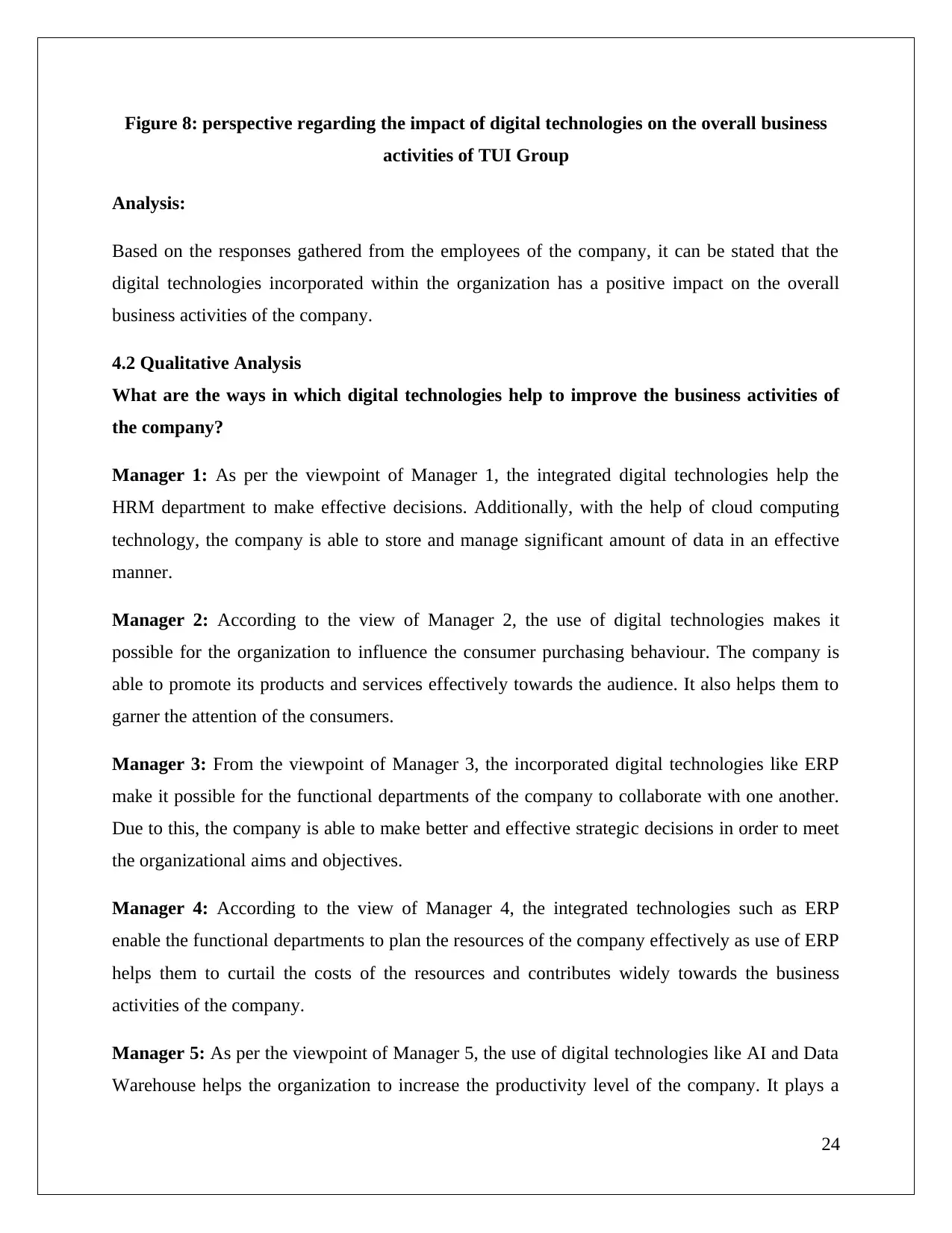
Figure 8: perspective regarding the impact of digital technologies on the overall business
activities of TUI Group
Analysis:
Based on the responses gathered from the employees of the company, it can be stated that the
digital technologies incorporated within the organization has a positive impact on the overall
business activities of the company.
4.2 Qualitative Analysis
What are the ways in which digital technologies help to improve the business activities of
the company?
Manager 1: As per the viewpoint of Manager 1, the integrated digital technologies help the
HRM department to make effective decisions. Additionally, with the help of cloud computing
technology, the company is able to store and manage significant amount of data in an effective
manner.
Manager 2: According to the view of Manager 2, the use of digital technologies makes it
possible for the organization to influence the consumer purchasing behaviour. The company is
able to promote its products and services effectively towards the audience. It also helps them to
garner the attention of the consumers.
Manager 3: From the viewpoint of Manager 3, the incorporated digital technologies like ERP
make it possible for the functional departments of the company to collaborate with one another.
Due to this, the company is able to make better and effective strategic decisions in order to meet
the organizational aims and objectives.
Manager 4: According to the view of Manager 4, the integrated technologies such as ERP
enable the functional departments to plan the resources of the company effectively as use of ERP
helps them to curtail the costs of the resources and contributes widely towards the business
activities of the company.
Manager 5: As per the viewpoint of Manager 5, the use of digital technologies like AI and Data
Warehouse helps the organization to increase the productivity level of the company. It plays a
24
activities of TUI Group
Analysis:
Based on the responses gathered from the employees of the company, it can be stated that the
digital technologies incorporated within the organization has a positive impact on the overall
business activities of the company.
4.2 Qualitative Analysis
What are the ways in which digital technologies help to improve the business activities of
the company?
Manager 1: As per the viewpoint of Manager 1, the integrated digital technologies help the
HRM department to make effective decisions. Additionally, with the help of cloud computing
technology, the company is able to store and manage significant amount of data in an effective
manner.
Manager 2: According to the view of Manager 2, the use of digital technologies makes it
possible for the organization to influence the consumer purchasing behaviour. The company is
able to promote its products and services effectively towards the audience. It also helps them to
garner the attention of the consumers.
Manager 3: From the viewpoint of Manager 3, the incorporated digital technologies like ERP
make it possible for the functional departments of the company to collaborate with one another.
Due to this, the company is able to make better and effective strategic decisions in order to meet
the organizational aims and objectives.
Manager 4: According to the view of Manager 4, the integrated technologies such as ERP
enable the functional departments to plan the resources of the company effectively as use of ERP
helps them to curtail the costs of the resources and contributes widely towards the business
activities of the company.
Manager 5: As per the viewpoint of Manager 5, the use of digital technologies like AI and Data
Warehouse helps the organization to increase the productivity level of the company. It plays a
24
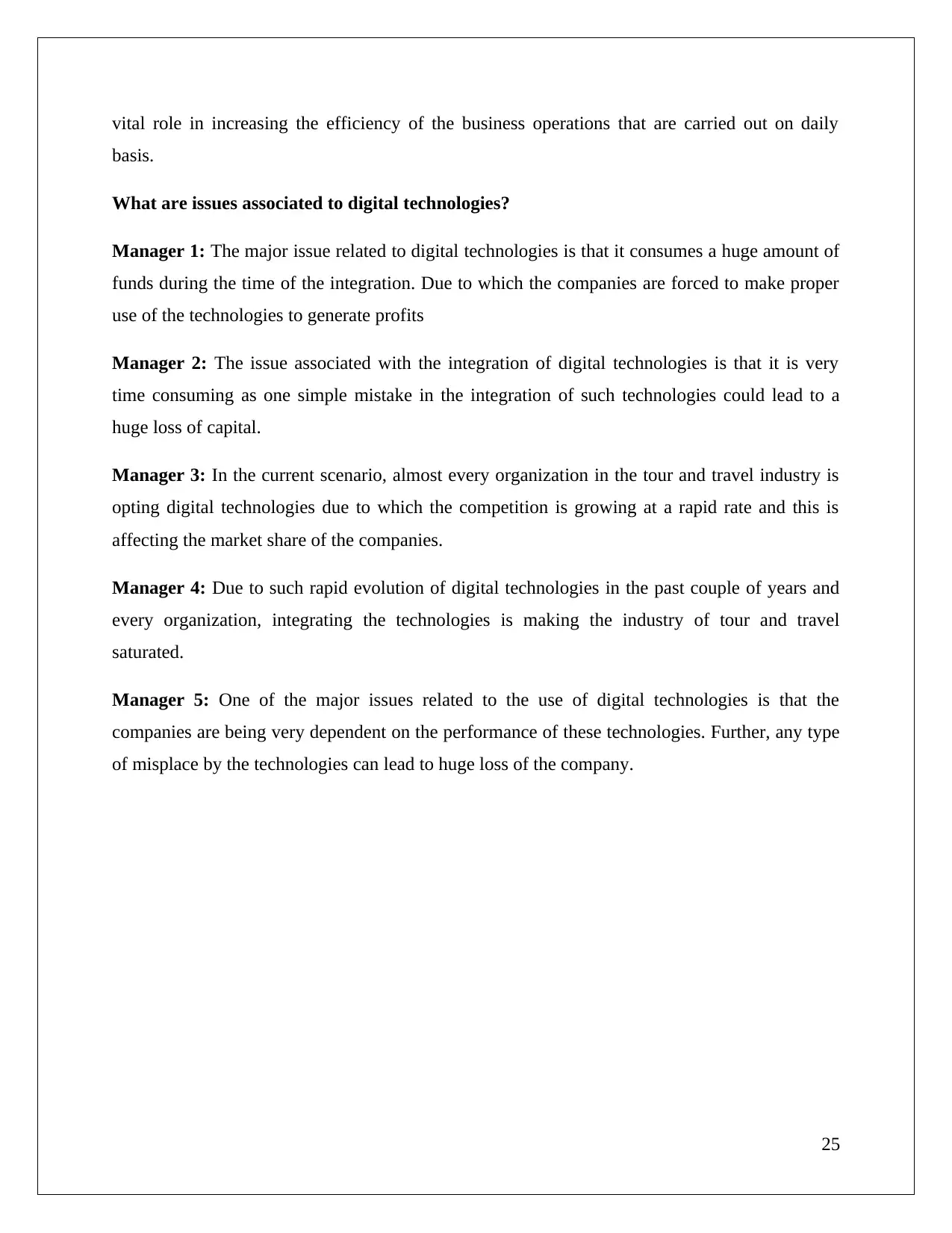
vital role in increasing the efficiency of the business operations that are carried out on daily
basis.
What are issues associated to digital technologies?
Manager 1: The major issue related to digital technologies is that it consumes a huge amount of
funds during the time of the integration. Due to which the companies are forced to make proper
use of the technologies to generate profits
Manager 2: The issue associated with the integration of digital technologies is that it is very
time consuming as one simple mistake in the integration of such technologies could lead to a
huge loss of capital.
Manager 3: In the current scenario, almost every organization in the tour and travel industry is
opting digital technologies due to which the competition is growing at a rapid rate and this is
affecting the market share of the companies.
Manager 4: Due to such rapid evolution of digital technologies in the past couple of years and
every organization, integrating the technologies is making the industry of tour and travel
saturated.
Manager 5: One of the major issues related to the use of digital technologies is that the
companies are being very dependent on the performance of these technologies. Further, any type
of misplace by the technologies can lead to huge loss of the company.
25
basis.
What are issues associated to digital technologies?
Manager 1: The major issue related to digital technologies is that it consumes a huge amount of
funds during the time of the integration. Due to which the companies are forced to make proper
use of the technologies to generate profits
Manager 2: The issue associated with the integration of digital technologies is that it is very
time consuming as one simple mistake in the integration of such technologies could lead to a
huge loss of capital.
Manager 3: In the current scenario, almost every organization in the tour and travel industry is
opting digital technologies due to which the competition is growing at a rapid rate and this is
affecting the market share of the companies.
Manager 4: Due to such rapid evolution of digital technologies in the past couple of years and
every organization, integrating the technologies is making the industry of tour and travel
saturated.
Manager 5: One of the major issues related to the use of digital technologies is that the
companies are being very dependent on the performance of these technologies. Further, any type
of misplace by the technologies can lead to huge loss of the company.
25
Secure Best Marks with AI Grader
Need help grading? Try our AI Grader for instant feedback on your assignments.
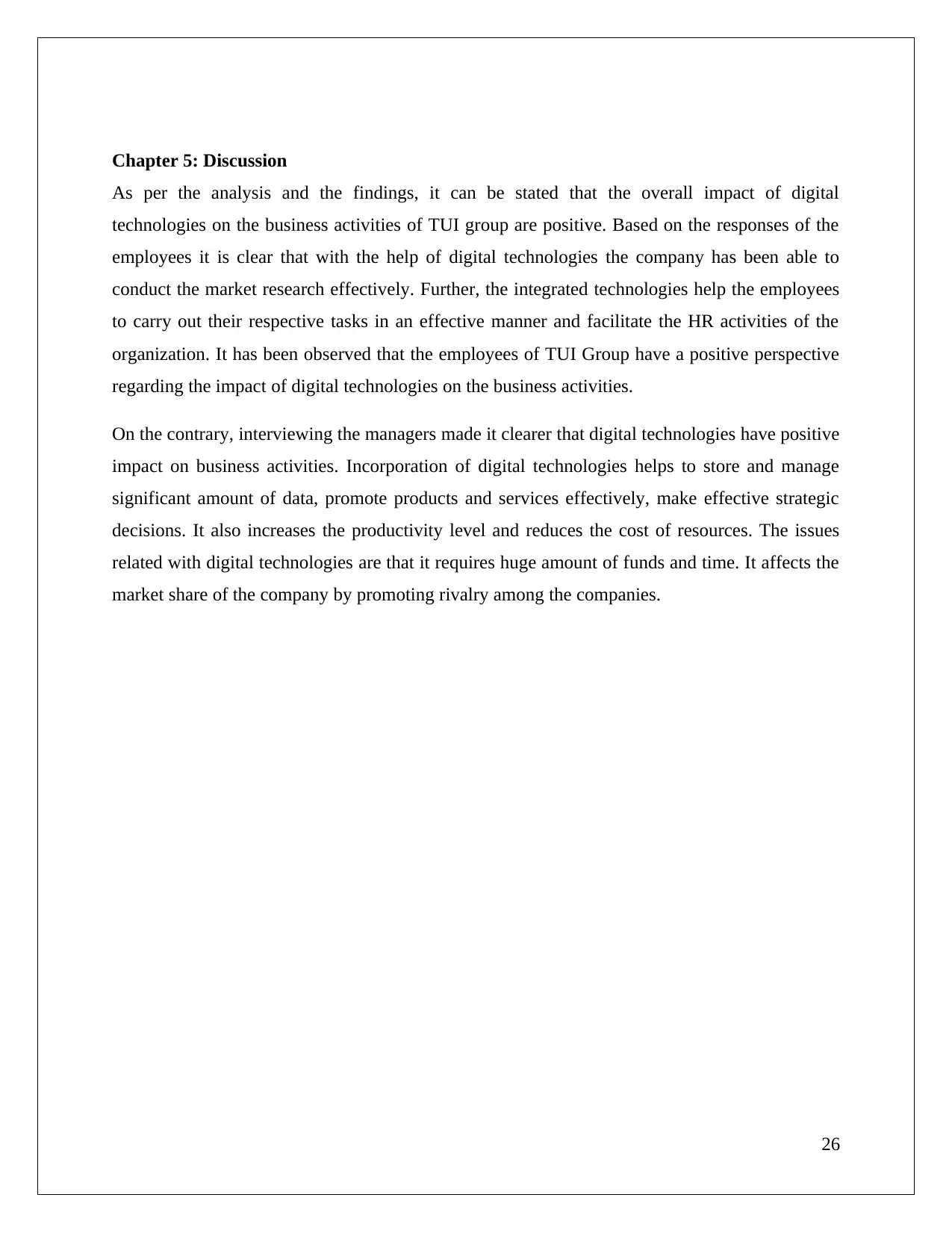
Chapter 5: Discussion
As per the analysis and the findings, it can be stated that the overall impact of digital
technologies on the business activities of TUI group are positive. Based on the responses of the
employees it is clear that with the help of digital technologies the company has been able to
conduct the market research effectively. Further, the integrated technologies help the employees
to carry out their respective tasks in an effective manner and facilitate the HR activities of the
organization. It has been observed that the employees of TUI Group have a positive perspective
regarding the impact of digital technologies on the business activities.
On the contrary, interviewing the managers made it clearer that digital technologies have positive
impact on business activities. Incorporation of digital technologies helps to store and manage
significant amount of data, promote products and services effectively, make effective strategic
decisions. It also increases the productivity level and reduces the cost of resources. The issues
related with digital technologies are that it requires huge amount of funds and time. It affects the
market share of the company by promoting rivalry among the companies.
26
As per the analysis and the findings, it can be stated that the overall impact of digital
technologies on the business activities of TUI group are positive. Based on the responses of the
employees it is clear that with the help of digital technologies the company has been able to
conduct the market research effectively. Further, the integrated technologies help the employees
to carry out their respective tasks in an effective manner and facilitate the HR activities of the
organization. It has been observed that the employees of TUI Group have a positive perspective
regarding the impact of digital technologies on the business activities.
On the contrary, interviewing the managers made it clearer that digital technologies have positive
impact on business activities. Incorporation of digital technologies helps to store and manage
significant amount of data, promote products and services effectively, make effective strategic
decisions. It also increases the productivity level and reduces the cost of resources. The issues
related with digital technologies are that it requires huge amount of funds and time. It affects the
market share of the company by promoting rivalry among the companies.
26
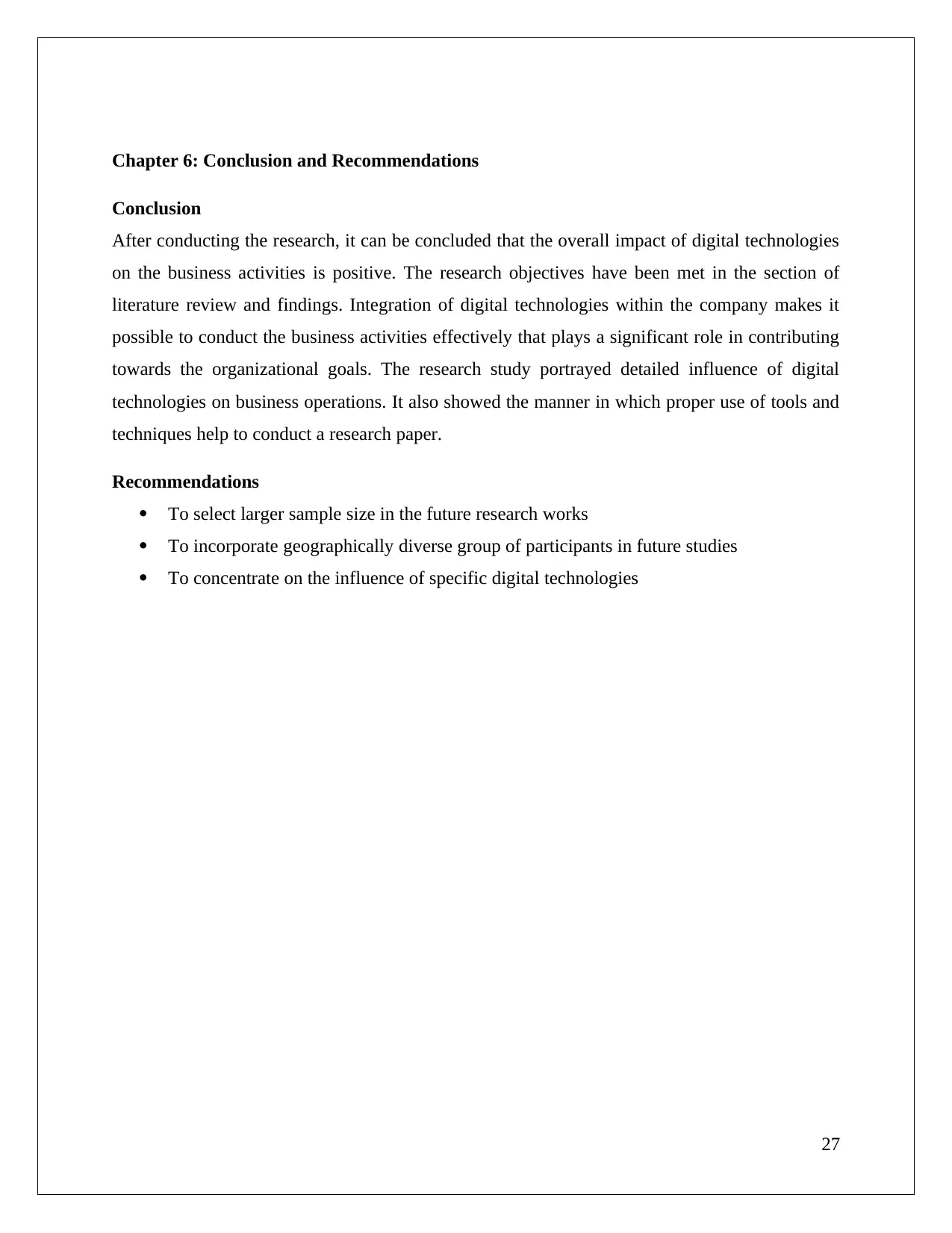
Chapter 6: Conclusion and Recommendations
Conclusion
After conducting the research, it can be concluded that the overall impact of digital technologies
on the business activities is positive. The research objectives have been met in the section of
literature review and findings. Integration of digital technologies within the company makes it
possible to conduct the business activities effectively that plays a significant role in contributing
towards the organizational goals. The research study portrayed detailed influence of digital
technologies on business operations. It also showed the manner in which proper use of tools and
techniques help to conduct a research paper.
Recommendations
To select larger sample size in the future research works
To incorporate geographically diverse group of participants in future studies
To concentrate on the influence of specific digital technologies
27
Conclusion
After conducting the research, it can be concluded that the overall impact of digital technologies
on the business activities is positive. The research objectives have been met in the section of
literature review and findings. Integration of digital technologies within the company makes it
possible to conduct the business activities effectively that plays a significant role in contributing
towards the organizational goals. The research study portrayed detailed influence of digital
technologies on business operations. It also showed the manner in which proper use of tools and
techniques help to conduct a research paper.
Recommendations
To select larger sample size in the future research works
To incorporate geographically diverse group of participants in future studies
To concentrate on the influence of specific digital technologies
27
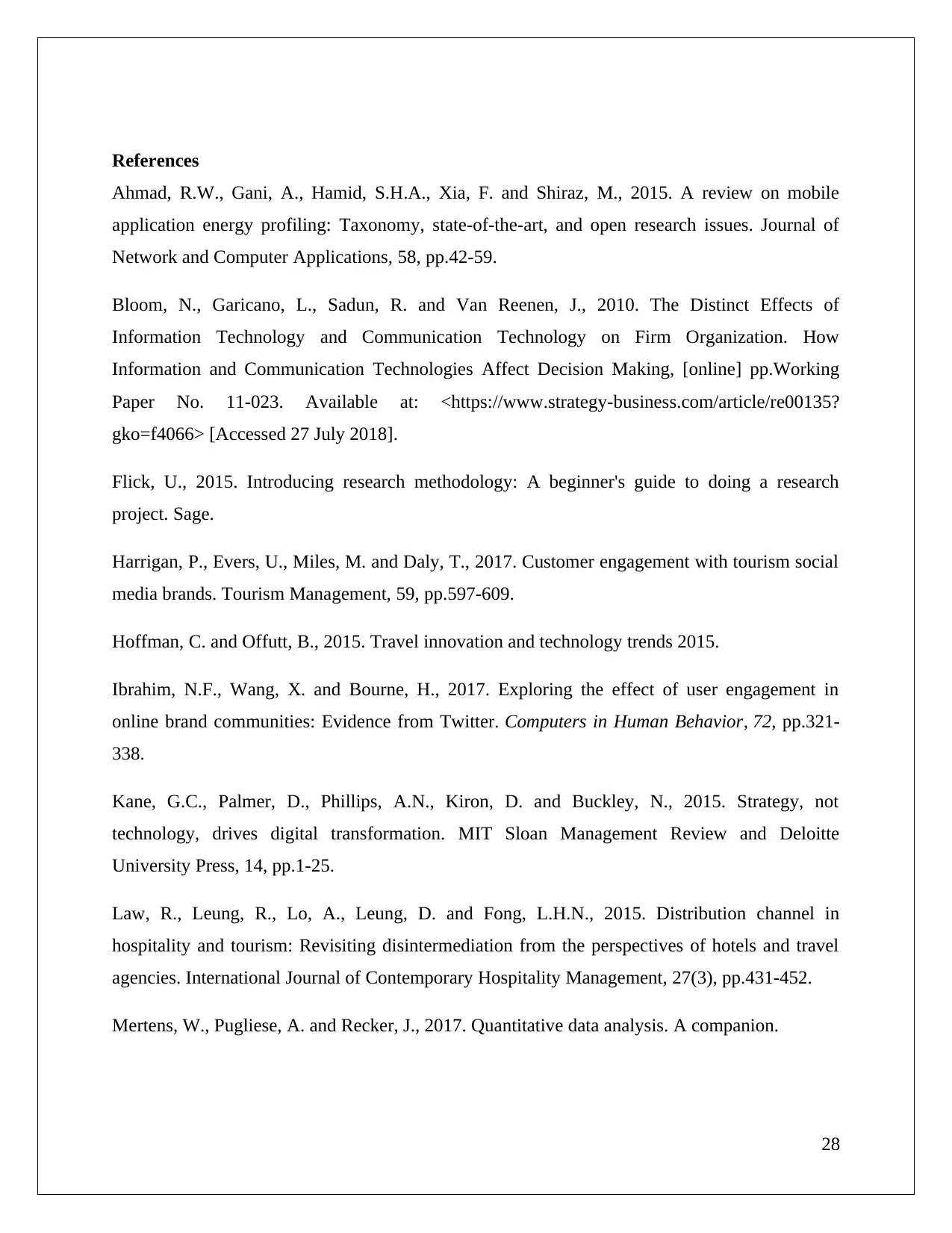
References
Ahmad, R.W., Gani, A., Hamid, S.H.A., Xia, F. and Shiraz, M., 2015. A review on mobile
application energy profiling: Taxonomy, state-of-the-art, and open research issues. Journal of
Network and Computer Applications, 58, pp.42-59.
Bloom, N., Garicano, L., Sadun, R. and Van Reenen, J., 2010. The Distinct Effects of
Information Technology and Communication Technology on Firm Organization. How
Information and Communication Technologies Affect Decision Making, [online] pp.Working
Paper No. 11-023. Available at: <https://www.strategy-business.com/article/re00135?
gko=f4066> [Accessed 27 July 2018].
Flick, U., 2015. Introducing research methodology: A beginner's guide to doing a research
project. Sage.
Harrigan, P., Evers, U., Miles, M. and Daly, T., 2017. Customer engagement with tourism social
media brands. Tourism Management, 59, pp.597-609.
Hoffman, C. and Offutt, B., 2015. Travel innovation and technology trends 2015.
Ibrahim, N.F., Wang, X. and Bourne, H., 2017. Exploring the effect of user engagement in
online brand communities: Evidence from Twitter. Computers in Human Behavior, 72, pp.321-
338.
Kane, G.C., Palmer, D., Phillips, A.N., Kiron, D. and Buckley, N., 2015. Strategy, not
technology, drives digital transformation. MIT Sloan Management Review and Deloitte
University Press, 14, pp.1-25.
Law, R., Leung, R., Lo, A., Leung, D. and Fong, L.H.N., 2015. Distribution channel in
hospitality and tourism: Revisiting disintermediation from the perspectives of hotels and travel
agencies. International Journal of Contemporary Hospitality Management, 27(3), pp.431-452.
Mertens, W., Pugliese, A. and Recker, J., 2017. Quantitative data analysis. A companion.
28
Ahmad, R.W., Gani, A., Hamid, S.H.A., Xia, F. and Shiraz, M., 2015. A review on mobile
application energy profiling: Taxonomy, state-of-the-art, and open research issues. Journal of
Network and Computer Applications, 58, pp.42-59.
Bloom, N., Garicano, L., Sadun, R. and Van Reenen, J., 2010. The Distinct Effects of
Information Technology and Communication Technology on Firm Organization. How
Information and Communication Technologies Affect Decision Making, [online] pp.Working
Paper No. 11-023. Available at: <https://www.strategy-business.com/article/re00135?
gko=f4066> [Accessed 27 July 2018].
Flick, U., 2015. Introducing research methodology: A beginner's guide to doing a research
project. Sage.
Harrigan, P., Evers, U., Miles, M. and Daly, T., 2017. Customer engagement with tourism social
media brands. Tourism Management, 59, pp.597-609.
Hoffman, C. and Offutt, B., 2015. Travel innovation and technology trends 2015.
Ibrahim, N.F., Wang, X. and Bourne, H., 2017. Exploring the effect of user engagement in
online brand communities: Evidence from Twitter. Computers in Human Behavior, 72, pp.321-
338.
Kane, G.C., Palmer, D., Phillips, A.N., Kiron, D. and Buckley, N., 2015. Strategy, not
technology, drives digital transformation. MIT Sloan Management Review and Deloitte
University Press, 14, pp.1-25.
Law, R., Leung, R., Lo, A., Leung, D. and Fong, L.H.N., 2015. Distribution channel in
hospitality and tourism: Revisiting disintermediation from the perspectives of hotels and travel
agencies. International Journal of Contemporary Hospitality Management, 27(3), pp.431-452.
Mertens, W., Pugliese, A. and Recker, J., 2017. Quantitative data analysis. A companion.
28
Paraphrase This Document
Need a fresh take? Get an instant paraphrase of this document with our AI Paraphraser
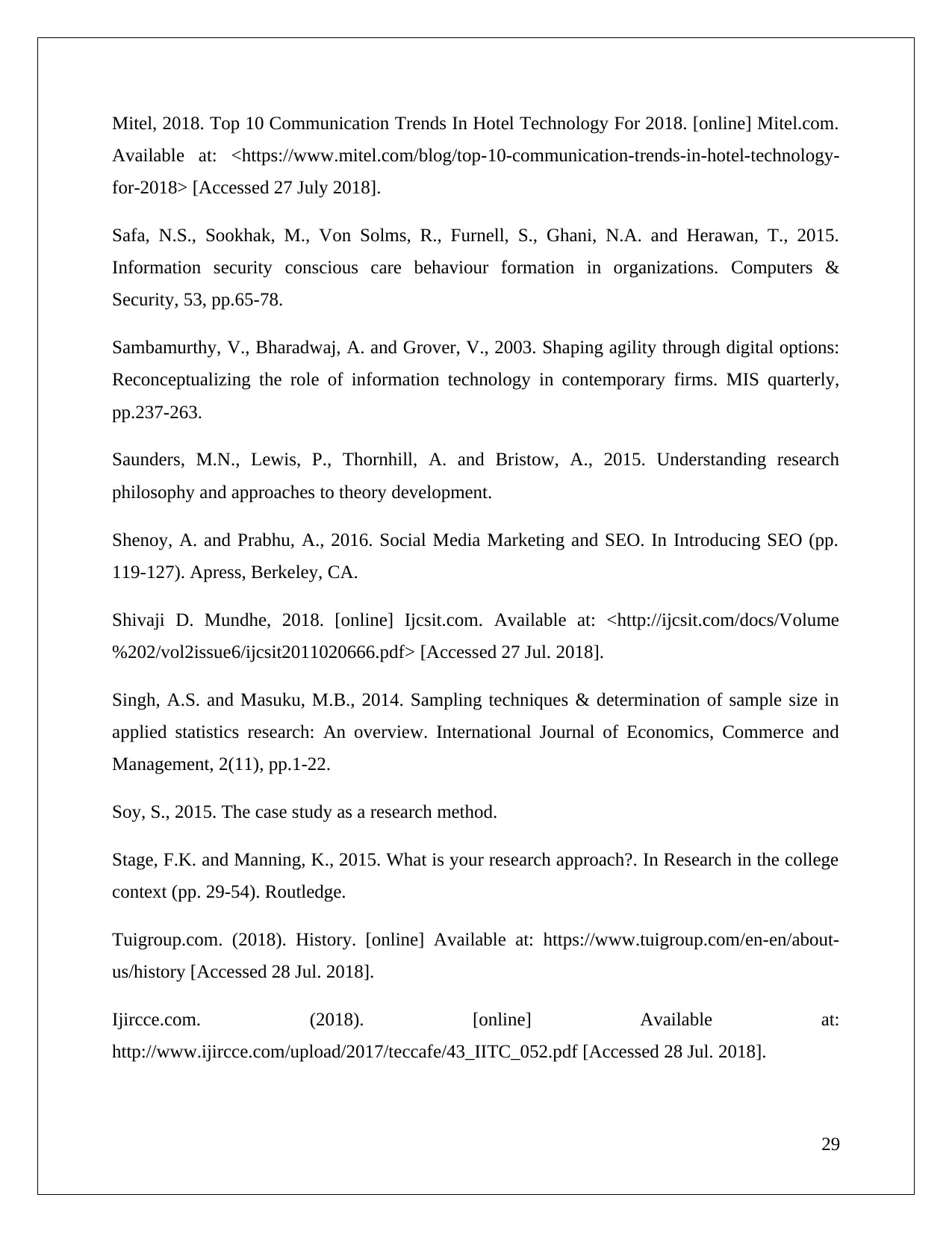
Mitel, 2018. Top 10 Communication Trends In Hotel Technology For 2018. [online] Mitel.com.
Available at: <https://www.mitel.com/blog/top-10-communication-trends-in-hotel-technology-
for-2018> [Accessed 27 July 2018].
Safa, N.S., Sookhak, M., Von Solms, R., Furnell, S., Ghani, N.A. and Herawan, T., 2015.
Information security conscious care behaviour formation in organizations. Computers &
Security, 53, pp.65-78.
Sambamurthy, V., Bharadwaj, A. and Grover, V., 2003. Shaping agility through digital options:
Reconceptualizing the role of information technology in contemporary firms. MIS quarterly,
pp.237-263.
Saunders, M.N., Lewis, P., Thornhill, A. and Bristow, A., 2015. Understanding research
philosophy and approaches to theory development.
Shenoy, A. and Prabhu, A., 2016. Social Media Marketing and SEO. In Introducing SEO (pp.
119-127). Apress, Berkeley, CA.
Shivaji D. Mundhe, 2018. [online] Ijcsit.com. Available at: <http://ijcsit.com/docs/Volume
%202/vol2issue6/ijcsit2011020666.pdf> [Accessed 27 Jul. 2018].
Singh, A.S. and Masuku, M.B., 2014. Sampling techniques & determination of sample size in
applied statistics research: An overview. International Journal of Economics, Commerce and
Management, 2(11), pp.1-22.
Soy, S., 2015. The case study as a research method.
Stage, F.K. and Manning, K., 2015. What is your research approach?. In Research in the college
context (pp. 29-54). Routledge.
Tuigroup.com. (2018). History. [online] Available at: https://www.tuigroup.com/en-en/about-
us/history [Accessed 28 Jul. 2018].
Ijircce.com. (2018). [online] Available at:
http://www.ijircce.com/upload/2017/teccafe/43_IITC_052.pdf [Accessed 28 Jul. 2018].
29
Available at: <https://www.mitel.com/blog/top-10-communication-trends-in-hotel-technology-
for-2018> [Accessed 27 July 2018].
Safa, N.S., Sookhak, M., Von Solms, R., Furnell, S., Ghani, N.A. and Herawan, T., 2015.
Information security conscious care behaviour formation in organizations. Computers &
Security, 53, pp.65-78.
Sambamurthy, V., Bharadwaj, A. and Grover, V., 2003. Shaping agility through digital options:
Reconceptualizing the role of information technology in contemporary firms. MIS quarterly,
pp.237-263.
Saunders, M.N., Lewis, P., Thornhill, A. and Bristow, A., 2015. Understanding research
philosophy and approaches to theory development.
Shenoy, A. and Prabhu, A., 2016. Social Media Marketing and SEO. In Introducing SEO (pp.
119-127). Apress, Berkeley, CA.
Shivaji D. Mundhe, 2018. [online] Ijcsit.com. Available at: <http://ijcsit.com/docs/Volume
%202/vol2issue6/ijcsit2011020666.pdf> [Accessed 27 Jul. 2018].
Singh, A.S. and Masuku, M.B., 2014. Sampling techniques & determination of sample size in
applied statistics research: An overview. International Journal of Economics, Commerce and
Management, 2(11), pp.1-22.
Soy, S., 2015. The case study as a research method.
Stage, F.K. and Manning, K., 2015. What is your research approach?. In Research in the college
context (pp. 29-54). Routledge.
Tuigroup.com. (2018). History. [online] Available at: https://www.tuigroup.com/en-en/about-
us/history [Accessed 28 Jul. 2018].
Ijircce.com. (2018). [online] Available at:
http://www.ijircce.com/upload/2017/teccafe/43_IITC_052.pdf [Accessed 28 Jul. 2018].
29

30
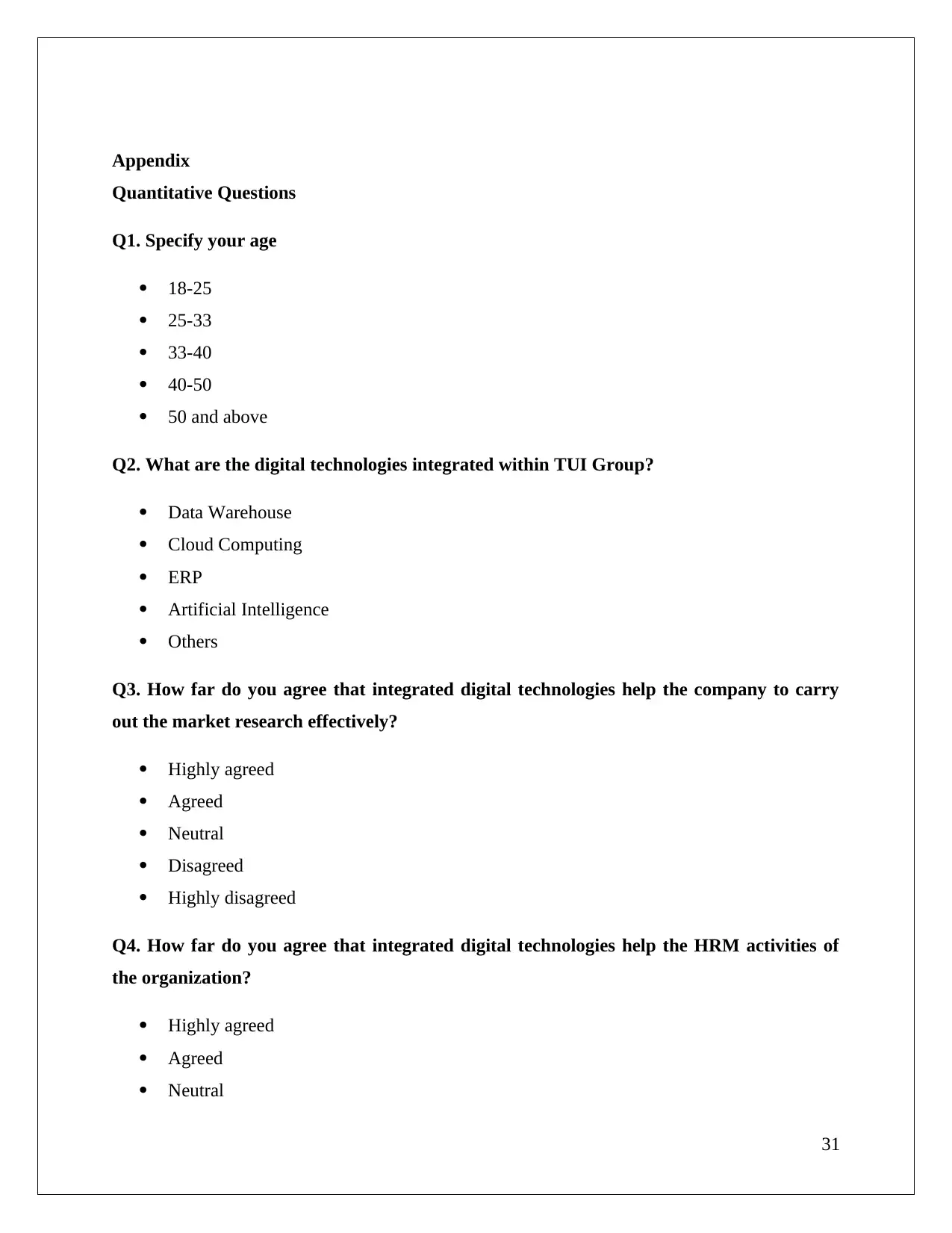
Appendix
Quantitative Questions
Q1. Specify your age
18-25
25-33
33-40
40-50
50 and above
Q2. What are the digital technologies integrated within TUI Group?
Data Warehouse
Cloud Computing
ERP
Artificial Intelligence
Others
Q3. How far do you agree that integrated digital technologies help the company to carry
out the market research effectively?
Highly agreed
Agreed
Neutral
Disagreed
Highly disagreed
Q4. How far do you agree that integrated digital technologies help the HRM activities of
the organization?
Highly agreed
Agreed
Neutral
31
Quantitative Questions
Q1. Specify your age
18-25
25-33
33-40
40-50
50 and above
Q2. What are the digital technologies integrated within TUI Group?
Data Warehouse
Cloud Computing
ERP
Artificial Intelligence
Others
Q3. How far do you agree that integrated digital technologies help the company to carry
out the market research effectively?
Highly agreed
Agreed
Neutral
Disagreed
Highly disagreed
Q4. How far do you agree that integrated digital technologies help the HRM activities of
the organization?
Highly agreed
Agreed
Neutral
31
Secure Best Marks with AI Grader
Need help grading? Try our AI Grader for instant feedback on your assignments.
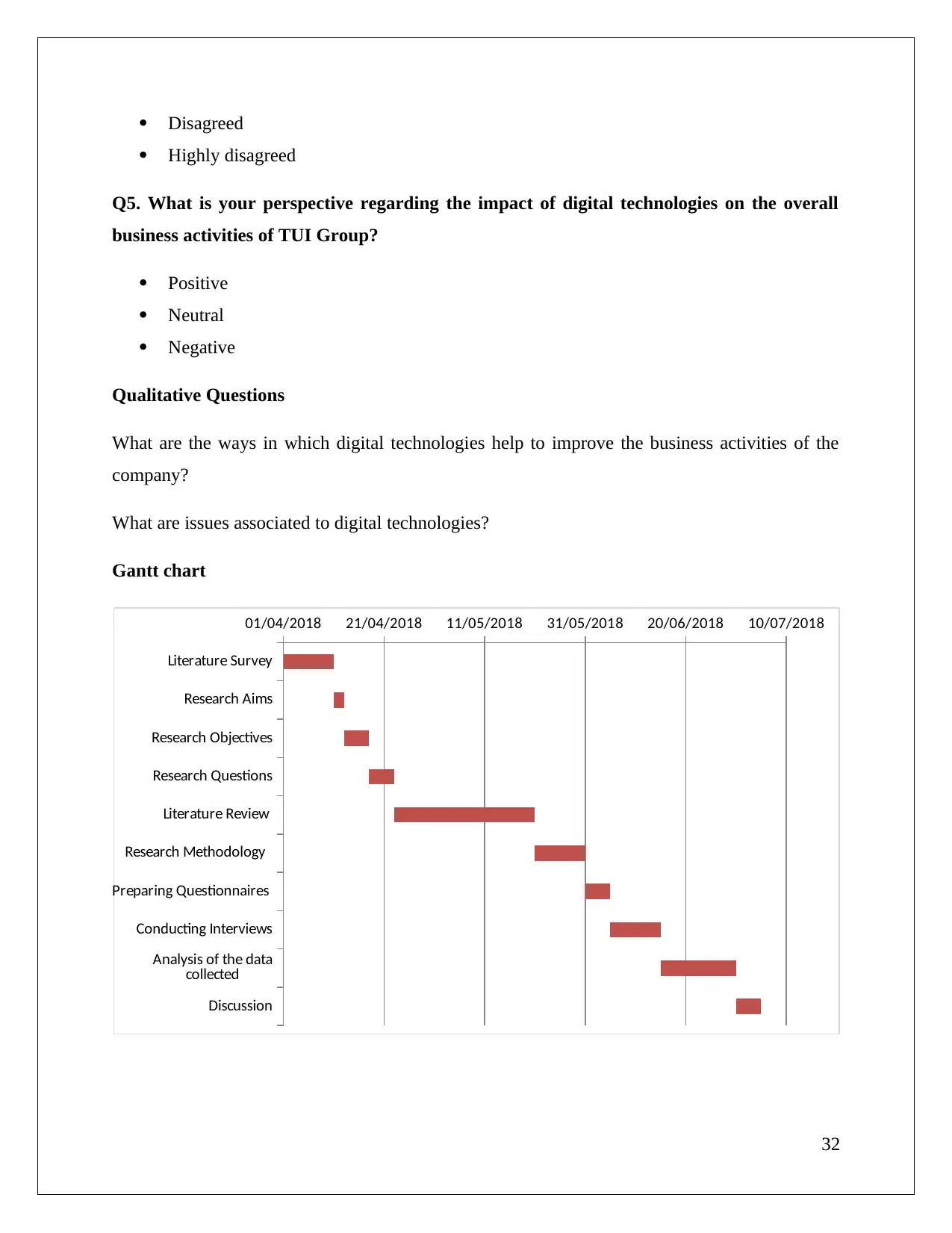
Disagreed
Highly disagreed
Q5. What is your perspective regarding the impact of digital technologies on the overall
business activities of TUI Group?
Positive
Neutral
Negative
Qualitative Questions
What are the ways in which digital technologies help to improve the business activities of the
company?
What are issues associated to digital technologies?
Gantt chart
Literature Survey
Research Aims
Research Objectives
Research Questions
Literature Review
Research Methodology
Preparing Questionnaires
Conducting Interviews
Analysis of the data
collected
Discussion
01/04/2018 21/04/2018 11/05/2018 31/05/2018 20/06/2018 10/07/2018
32
Highly disagreed
Q5. What is your perspective regarding the impact of digital technologies on the overall
business activities of TUI Group?
Positive
Neutral
Negative
Qualitative Questions
What are the ways in which digital technologies help to improve the business activities of the
company?
What are issues associated to digital technologies?
Gantt chart
Literature Survey
Research Aims
Research Objectives
Research Questions
Literature Review
Research Methodology
Preparing Questionnaires
Conducting Interviews
Analysis of the data
collected
Discussion
01/04/2018 21/04/2018 11/05/2018 31/05/2018 20/06/2018 10/07/2018
32

33
1 out of 33
Related Documents
Your All-in-One AI-Powered Toolkit for Academic Success.
+13062052269
info@desklib.com
Available 24*7 on WhatsApp / Email
![[object Object]](/_next/static/media/star-bottom.7253800d.svg)
Unlock your academic potential
© 2024 | Zucol Services PVT LTD | All rights reserved.





